
More Recent Fishing Reports
Crappies 7-2 • Winnie 6-30 • Sundin 6-29 • Ely 06-28 • LOW 6-27 • URL 6-26 • Winnie 6-23 • Sundin 6-22 • Crappies 6-20 • Sundin 6-19 • Leech Lake 6-18 • Winnie 6-16 • Rod Storage 5-31 • Lake Superior 5-11 • Forward Sonar • Panfish Workgroup • Follow on Facebook
 Jeff Sundin June 29, 2023 "Mixing the Mix-Able"
Jeff Sundin June 29, 2023 "Mixing the Mix-Able"
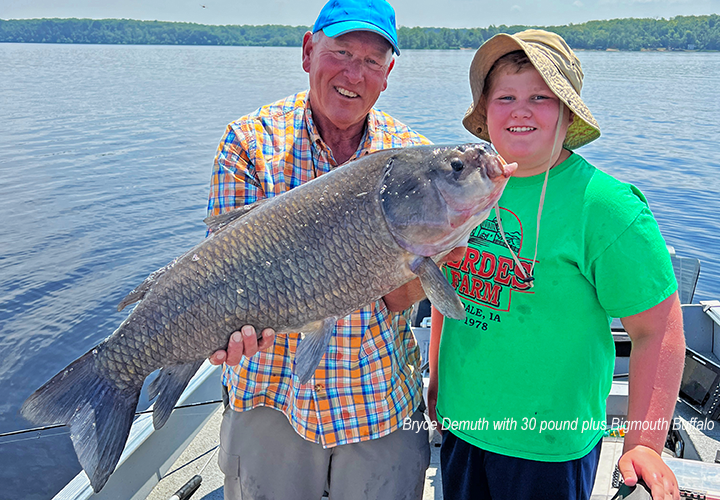 Family fishing trips, especially multiple day trips, usually offer me an excuse to combine the pursuit of walleye with other popular fish species. You’ve read plenty of times about how I love the mixed bag, multi-species action bite. If I keep the boat on lakes that have walleyes in them, we usually get enough, and along the way, who knows what else we’ll catch. Even after all these years, the past few days proved to me that the term “mixed bag” has still never been fully realized!
Family fishing trips, especially multiple day trips, usually offer me an excuse to combine the pursuit of walleye with other popular fish species. You’ve read plenty of times about how I love the mixed bag, multi-species action bite. If I keep the boat on lakes that have walleyes in them, we usually get enough, and along the way, who knows what else we’ll catch. Even after all these years, the past few days proved to me that the term “mixed bag” has still never been fully realized!
Bryce Demuth started his fishing trip at age 11 on Monday and finished it at age 12 on Wednesday. As it happened, the fish must have gotten a memo that all 3 days were his birthday and they gifted him accordingly. His parents Harv and Jodi held their own too, but somehow Bryce just keeps winding up catching the biggest, sometimes the most, and this year, the most unusual.
The photo of the Bigmouth Buffalo you see here does not do this fish justice. The bright sunshine, combined with photos being snapped quickly didn’t capture the deep, silvery blue hues and highlights. The depth of the fish isn’t fully realized either, to me, it seemed like the circumference would be greater than the length. We did not have a scale to weigh the 32-inch fish, but I can tell you it was heavy, and it reminded me of holding a bag of water softener salt.
 The buffalo, the first one ever caught in my boat, struck a spinner tipped with a fathead minnow while we were fishing for walleyes. The screen image of the structure, a mid-lake bar that topped off at about 12 feet deep offered no clue that we’d catch that fish. When Bryce first hooked up, he feared being snagged in the rocks, but something didn’t look right to me, the reel’s drag was not spinning, and the rod was throbbing, giving me the sense that something big was on the hook; obviously there was.
The buffalo, the first one ever caught in my boat, struck a spinner tipped with a fathead minnow while we were fishing for walleyes. The screen image of the structure, a mid-lake bar that topped off at about 12 feet deep offered no clue that we’d catch that fish. When Bryce first hooked up, he feared being snagged in the rocks, but something didn’t look right to me, the reel’s drag was not spinning, and the rod was throbbing, giving me the sense that something big was on the hook; obviously there was.
Not long before Bryce’s adventure, Harv, his dad, added a notch to my mixed bag belt too. Harv’s contribution to my list of first time ever happenings were a nice channel catfish that struck his spinner while we fished on a different bar. That fish piqued my interest because when I and the Hippie Chick went on our big catfish adventure to Selkirk, we never caught one that was legally harvestable.
Because I don’t get the chance to fish for them, I’ve never had a chance to share a meal of them with her. Thanks to Harv’s generosity, his catfish finally offered a chance to cook one for Susan. As you can see, I did that last night and I promise you that it tasted every bit as good as the image shows.
The rest of the fishing story goes a lot like you probably imagined. We trolled spinners tipped with minnows and fished along weed edges, and mid-lake bars. Because we fished on 3 different lakes, 80 miles separating them, the variety of fish species was broad. Depending on the day, and the spots, we caught pike, sunfish, crappies, walleyes, largemouth bass, rock bass, perch. If we hadn’t eaten some for a shore dinner, they’d have gone home with limits of walleye and crappie, but even after cooking, the total counts were still close.
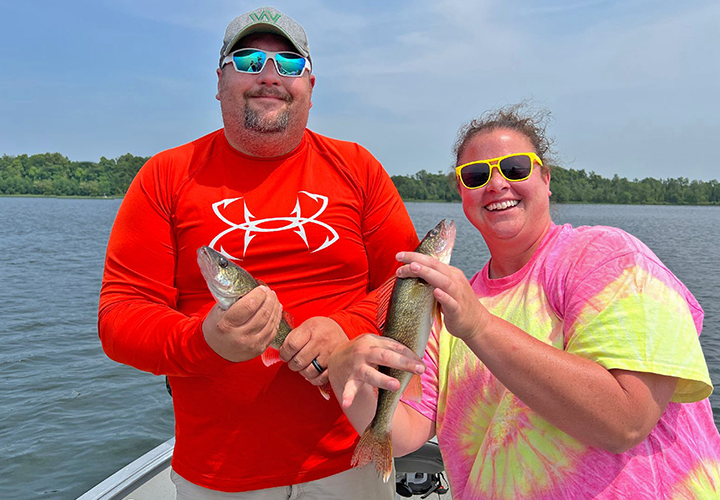 It was not planned, but coincidentally, all 3 lakes of the small lakes were connected to the Mississippi River in one way or another. Sometime in the future, I’d be tempted to make a more deliberate effort to fish on all the Minnesota waters connected to the river. It would be fun I think, and who knows how many other species we’d catch?
It was not planned, but coincidentally, all 3 lakes of the small lakes were connected to the Mississippi River in one way or another. Sometime in the future, I’d be tempted to make a more deliberate effort to fish on all the Minnesota waters connected to the river. It would be fun I think, and who knows how many other species we’d catch?
You deserve one paragraph of hard facts about the 3-day trip, so here goes. Water temperatures ranged from 70 to 72 degrees, cooler now than they were a few weeks ago. Because of the relatively cool temps, the spinner bite is not at full peak yet.
When surface temperatures get warmer, panfish and bass become more active and that’s when the action gets hot and heavy. On this trip, there were times when we put away the spinners and fished with jigs tipped with Ripple Shads, that presentation worked for walleyes. We fished with slip floats and leeches on mid-lake bars too, and that presentation accounted for the most “harvestable” walleyes. If we had been singling them out specifically, I think we would have spent more time bobber fishing and less time trolling spinners.
The weather forecast looks favorable for folks headed toward the lake for the Independence Day holiday. More warm temperatures and more sunshine will encourage the mixed-bag, action bite, so pack your spinners for that. Walleye purists, crappie experts too, should plan to fish during low light periods. The past 2 weeks have featured great action at dawn and dusk, even on lakes that feel like dead seas during the daytime.
Today, I have a trip with new customers and believe that catching walleyes will be the main goal of the day. So, I’ll do my best to nail down more “hard news” about where and how they can be caught this weekend. Check back for an update about that. ![]() — Jeff Sundin 218-245-9858 or EMAIL
— Jeff Sundin 218-245-9858 or EMAIL
More Recent Fishing Reports
Winnie 6-30 • Sundin 6-29 • Ely 06-28 • LOW 6-27 • URL 6-26 • Winnie 6-23 • Sundin 6-22 • Crappies 6-20 • Sundin 6-19 • Leech Lake 6-18 • Winnie 6-16 • Rod Storage 5-31 • Lake Superior 5-11 • Walleye Stocking 5-3 • Walleye Stamp 3-3 • Forward Sonar • Panfish Workgroup • Follow on Facebook
 Ely Area, Arrowhead Outdoors Fishing Report June 28, 2023
Ely Area, Arrowhead Outdoors Fishing Report June 28, 2023
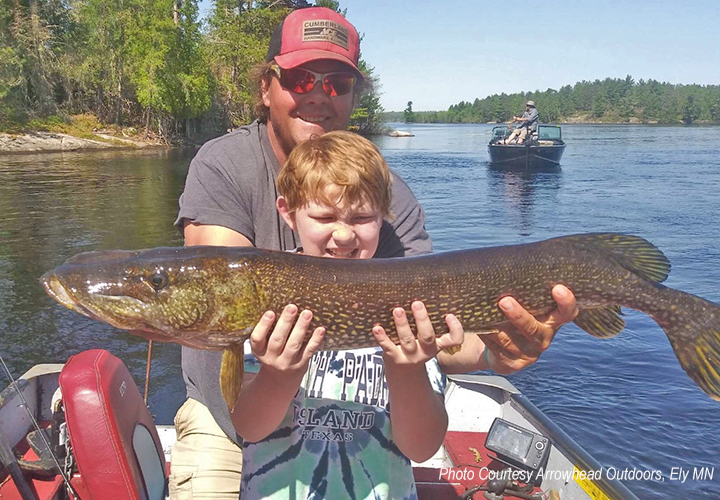 "Walleye fishing can't be fantastic all the time, even in the Ely area. Anglers have been struggling to stay on the walleyes this last week. Anglers catching walleyes have been reporting that they are finding them in 12-18 feet of water, out on sunken islands. Spinner rigs, tipped with crawlers has been best, but jig and half a crawler has also been very effective. Top colors have been orange, gold and pink.
"Walleye fishing can't be fantastic all the time, even in the Ely area. Anglers have been struggling to stay on the walleyes this last week. Anglers catching walleyes have been reporting that they are finding them in 12-18 feet of water, out on sunken islands. Spinner rigs, tipped with crawlers has been best, but jig and half a crawler has also been very effective. Top colors have been orange, gold and pink.
Smallmouth Bass fishing too has slowed on some of the area lakes, but has changed very little on others. Topwater continues to be the way to go on the lakes where the bite is still good. Aggressive bass are being found on classic smallmouth locations like boulder flats, points and downed trees. If bass aren't smashing topwater baits, wacky rigs have been extremely effective too, in the same areas.
Pike have been active this last week. Anglers have been catching good numbers of pike under 30 inches with a few over 40 inches still being caught. Spoons, spinnerbaits, and suckers under a bobber have been effective for anglers. Wedline's, river mouths and mouths of shallow bays has been the areas to key in on if you want to catch pike.
Lake Trout Anglers were doing good catching lakers this last week. Trolling with leadcore and trolling spoons, over 30-80 feet of water has been effective. Anglers have been finding lakers close to sunken islands and off points." — Arrowhead Outdoors, 218-365-5358
 Lake of the Woods, LOW Tourism June 27, 2023
Lake of the Woods, LOW Tourism June 27, 2023
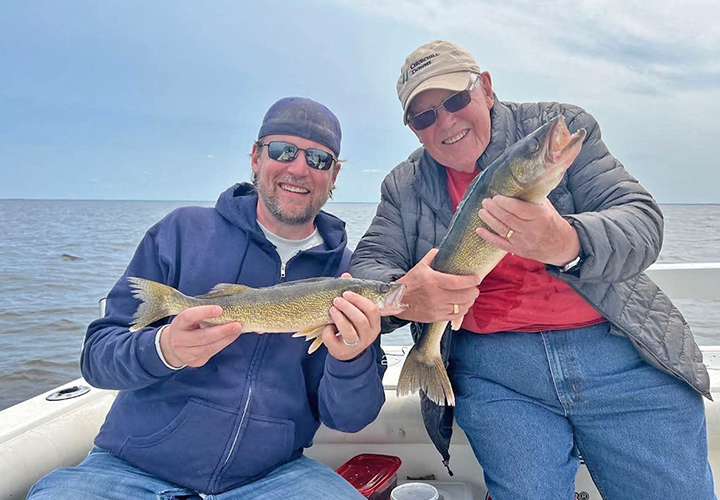 "There's an incredible week of fishing goin on at the south end Lake of the Woods, the lake continues to put out big numbers of walleyes and saugers of all sizes.
"There's an incredible week of fishing goin on at the south end Lake of the Woods, the lake continues to put out big numbers of walleyes and saugers of all sizes.
There are two areas where most anglers have focused this past week. First, rocks. Walleyes love crayfish on LOW and nice fish have been found over various rocky areas targeting crayfish. The second area that has really fired up nicely is the deep mud. There is usually a transition this time of year.
Walleyes are feeding on baitfish and bug hatches. Did you know when there is a bug hatch, most of those bugs come from the bottom of the lake from the mud in a larval stage? Walleyes love the nymph forms of various insects, and eat them before they fully emerge from the mud. If that nymph avoids the fish and makes it to the surface, it sheds its covering and flies away.
Various techniques are catching walleyes. The most common technique catching walleyes is drifting or trolling crawler harnesses. A two hook snelled spinner with a crawler and 1 to 2 ounce inline sinker or bottom bouncer drifted or trolled at 7.5 to 1.25 MPH will catch walleyes. Some anglers are using leeches on a snelled spinner with success as well. A tip for pulling spinners and crawler harnesses is to maintain a 45 degree angle with your presentation and don't drag it, keep the sinker several inches above the bottom. Oftentimes, a fish will feel like a wet sock rather than hitting it hard. That's when you should set the hook!
Jigging with minnows or a leech is effective on structure or where fish aren't so spread out. Trolling crankbaits is an effective way to catch walleyes much of the open water season. Try the first or last couple of hours of the day trolling shorelines in addition to deeper fish over the basin.
Most walleyes are being caught in 12 to 25 feet of water, with various shallow bites also taking place in areas. Walleyes fugure out where forage is abundant, and in those areas walleyes are taking advantage of.
Other species are also available and often caught by walleye anglers. Pike, muskies, sturgeon, smallmouth bass, jumbo perch, and crappies are a few.
 On the Rainy River, anglers are catching "local" walleyes, or walleyes that live in the river. The river offers various areas of structure and a variety of forage that holds fish all year long. Keep this in mind on an extra windy day or simply for a change of scenery.
On the Rainy River, anglers are catching "local" walleyes, or walleyes that live in the river. The river offers various areas of structure and a variety of forage that holds fish all year long. Keep this in mind on an extra windy day or simply for a change of scenery.
The same techniques that work on the lake work on the river, often with a tweak. You may have to alter the weight of a jig due to current or troll upstream, for example. Good numbers of smallmouth bass. Look for boulders, rubble, bridges and current breaks. For pike, bays, feeder rivers and weed edges.
The sturgeon season opens this week on July 1st. This is a "keep" season. If you want to harvest a sturgeon in the Rainy River or LOW, one sturgeon is allowed per calendar year per angler. It must be 45 to 50 inches or over 75 inches. A sturgeon tag is available for $5.00 and without it, anglers must catch and release only.
Up at the Northwest Angle, Walleye fishing is excellent with impressive numbers of walleyes on both sides of the border. With resorts up at the Angle being literally, right on the border, many anglers fish Ontario waters.
Anglers are allowed to boat into Canada without having to clear customs as long as they don't touch land, anchor, moor, touch a dock or exchange goods or services. An Ontario fishing license for zone 5 is required to fish this area and different lengths and limits vs MN applies.
Jigging is more common year round in these parts due to the structure and many more rocky areas. With that being said, crawler harnesses are putting a lot of walleyes in the boat. The flash, vibration combined with a live bait offering is hard for a walleye to resist. Keep your bottom bouncer just above the rocks or mud.
Smallmouth bass are in good numbers along shoreline structure. Pike can be found in bays and targeting points. The muskie season is open and great reports continue. With 14,552 islands in LOW, structure and forage is excellent for world class muskie fishing." — Lake of the Woods Tourism, (800) 382-FISH
 Wired2Fish "Comparing LakeMaster, Navionics and C-Map" June 26, 2023
Wired2Fish "Comparing LakeMaster, Navionics and C-Map" June 26, 2023
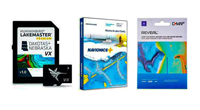 "Having good mapping is essential for being efficient on the water. This is especially true during the summer months when the majority of fish are located offshore. Having an accurate map helps with not only safely navigating your waterway, but it also allows you to have a better understanding of your lakes contours and underwater structures. This understanding directly relates to making you a more efficient and successful angler.
"Having good mapping is essential for being efficient on the water. This is especially true during the summer months when the majority of fish are located offshore. Having an accurate map helps with not only safely navigating your waterway, but it also allows you to have a better understanding of your lakes contours and underwater structures. This understanding directly relates to making you a more efficient and successful angler.
Each map can have varying contours and preloaded structure depending on how recent your map is. There are numerous different mapping companies available who all offer a different variety of maps, each of which has their own benefits. Some of the most popular companies include C-Map, Navionics and LakeMaster. This feature will cover some of the most important aspects of choosing and utilizing the best map for you to ..."Learn More >> Comparing LakeMaster, Navionics and C-Map
 Jeff Sundin June 22, 2023 "Are We Early, or Did We Miss the Boat?"
Jeff Sundin June 22, 2023 "Are We Early, or Did We Miss the Boat?"
 If I told you that some lakes in north central Minnesota are ahead of schedule in terms of the progression of summer fishing patterns, and some lakes are behind schedule, would you say I’m full of B as in B, S as in S? Or would you offer me the chance to explain why I’m thinking that?
If I told you that some lakes in north central Minnesota are ahead of schedule in terms of the progression of summer fishing patterns, and some lakes are behind schedule, would you say I’m full of B as in B, S as in S? Or would you offer me the chance to explain why I’m thinking that?
I know that not everybody buys in to some of my theories, especially that one dude. But I know too that some of you do like to engage in theoretical thinking, so for you I’ll explain in the way of my own fishing timeline.
Let’s start with a crappie fishing charter that Larry, Tim, and Cooley were on with me last Thursday. The water temperature of the lake we fished on was warm, somewhere in the mid-70s, so despite the effects of a cool front, fish were active. We trolled spinners on the weed edges and as planned, caught crappies. But there were tons of rock bass, sunfish, bass and pike on the same deep weed edges and they were all equally aggressive. The experience convinced me that warm water species like sunfish and bass had completed spawning, and had set up shop in deeper, weedy, mid-summer locations.
But on Monday, the lake I was on for another similar charter with Fritz and Penny Becker encouraged me to believe that exact opposite. Our goal was not to target crappies specifically, but we found them anyway. The presentation, trolling spinners along the outside weed edges produced worked very well. There were lots of them and they were aggressive, so were pike, rock bass, and even a few walleyes. But sunfish and bass, they were non-existent, and on a lake where we typically catch plenty of them, my thinking changed, maybe sunfish and bass were still in spawning territory, at least on that lake.
On Tuesday, my walleye charter with Bobby and Mark took place amidst the weeds. Walleyes were in July mode on that lake, hunkered down in mats of northern milfoil, sometimes so thick that we could barely move through it. But troll a spinner through the gaps, and walleye, perch and pike slammed it hard. Meanwhile, my buddy Reed Ylitalo was fishing on Winnie, catching walleyes like it was May, still using jigs and minnows in shallow, 10-to-12-foot water. So, which was it, were walleyes ahead or behind their seasonal patterns? I guess it depends on who you talk to, doesn’t it?
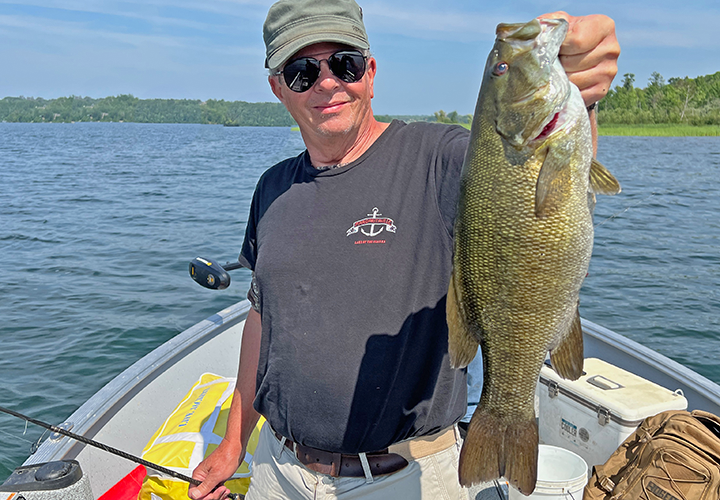 Yesterday, another charter with Bobby and Mark found me in hot pursuit of smallmouth bass. We caught some, but not where I was expecting. Instead of shallow, rocky water where I’d expect them to either be in spawning, or post spawning mode, they were cruising along the sand-grass breaklines in 12 to 14 feet of water. You can probably tell by looking at the photo of Mark’s smallmouth that she has not spawned yet. Neither had any of the other female fish that we caught yesterday. Walleye and pike were not set up in typical mid-lake, summer locations on that lake either, at least I could not find them out there. So, by the time we were done there, I was convinced that the fish were well behind their summer progressions.
Yesterday, another charter with Bobby and Mark found me in hot pursuit of smallmouth bass. We caught some, but not where I was expecting. Instead of shallow, rocky water where I’d expect them to either be in spawning, or post spawning mode, they were cruising along the sand-grass breaklines in 12 to 14 feet of water. You can probably tell by looking at the photo of Mark’s smallmouth that she has not spawned yet. Neither had any of the other female fish that we caught yesterday. Walleye and pike were not set up in typical mid-lake, summer locations on that lake either, at least I could not find them out there. So, by the time we were done there, I was convinced that the fish were well behind their summer progressions.
In the interest of time, I skipped over a few, less glaring examples, but I could offer more. My theory, still unproven, is that despite the warm weather we’ve experienced, high water from the snow melting in land-locked lakes with no outflow is holding them back, they appear to be behind schedule. Cooler water temperatures and less developed vegetation may be the cause, maybe there are factors I haven’t thought of yet as well.
Smaller lakes fed by rivers and streams that allow warm, flowing water in both directions, in and out, are either on, or ahead of their typical summer trajectories. That could explain why sunfish and bass were apparently ahead of schedule, on the shallow water flowage I fished last Thursday. It could also explain why bass and sunfish appeared to be behind schedule on the deeper, land-locked lakes that the Becker’s fished with me on Monday.
Whether or not my theory is 100% accurate doesn’t matter that much. But knowing which type of lake I’m fishing on is probably gonna save me some time over the next couple of weeks. If I know ahead of time which areas of the lake are most likely to be holding fish, then my search for them will be more efficient. I know this isn’t a hard news report, offering GPS positions and precise presentations, but for you thinkers out there, my musings could be fun to test out, at least I hope so.
Today, my crew is larger than I can handle alone, so along with my fellow guide Justin Wiese, we’re Winnie bound. I haven’t been there this week, but reports from there have been good over the past few days. I’m excited about the chance to learn firsthand what’s going on out there, and will update you about that soon. ![]() — Jeff Sundin 218-245-9858 or EMAIL
— Jeff Sundin 218-245-9858 or EMAIL
 Lake of the Woods, LOW Tourism June 22, 2023
Lake of the Woods, LOW Tourism June 22, 2023
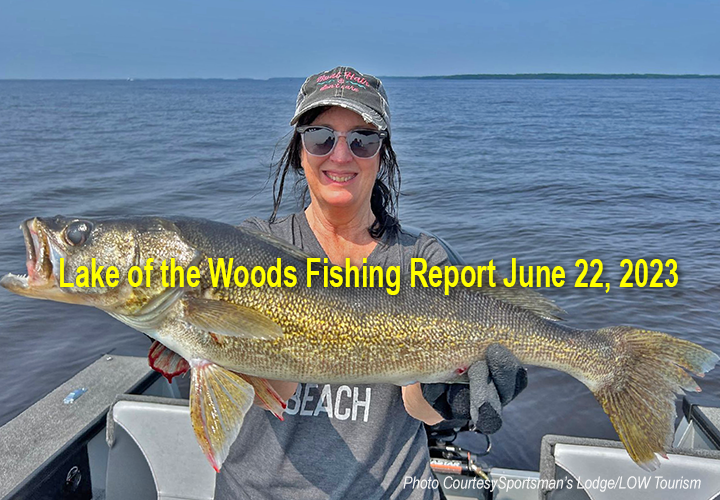 "Summer fishing is in full swing on the south end of Lake of the Woods. The lake is producing a nice mix of sizes, so anglers are getting ‘eating size” walleyes, along with some protected slot-fish and trophy fish in the mix.
"Summer fishing is in full swing on the south end of Lake of the Woods. The lake is producing a nice mix of sizes, so anglers are getting ‘eating size” walleyes, along with some protected slot-fish and trophy fish in the mix.
Most walleyes are being caught in 20 to 28 feet of water. Some nice walleye bites also take place in 8 to 15 feet, usually when forage is present. Fish are being caught at various locations across the south shore and up north by Garden Island.
Various techniques are catching walleyes. Crawler harnesses are working very well. A two hook snelled spinner with a crawler and 1 to 2-ounce inline sinkers or bottom bouncer drifted or trolled at around 1 mph will catch walleyes. A tip for crawler harnesses is to hook the front, dark part of the crawler on the front hook. Straighten the crawler and hook further back, toward the tail or midsection with the second hook. Have about 2 to 3 inches off the tail dangling from the back hook. If it's too long, pinch off the long tail.
Jigging with a minnow, and sometimes a leech, is still catching walleyes. Anchoring up and vertical jigging amongst fish is effective.
If you are struggling to catch fish, trolling crankbaits is a great way to find them. This technique helps put your lure in front of a lot of fish in the shortest time, and triggers reaction bites.
Nice pike are being caught by walleye anglers. Those targeting pike are working bays and shoreline structure.
On the Rainy River, the sturgeon season opens again July 1, 2023. In the meantime, anglers are catching walleyes in many of the traditional walleye haunts such as current breaks, holes, and rocky areas.
A jig and minnow in areas with structure or a current break is a good strategy. To find fish spread out on a flat or along a break, troll crankbaits or spinners with crawlers. Walleyes are the target, but these techniques catch a variety of species. Lots of smallmouth bass in the river. Target feeder rivers, bridges, and areas with rocks. For pike, weed beds, bays and feeder rivers to the Rainy River.
Up at the NW Angle, walleye fishing is excellent on both sides of the border. Most are jigging with a minnow or plastic on underwater points, neck down areas, flats with moving water and edges of reefs. Crawler harnesses work great for walleyes in the Angle too. In rocky areas, use a bottom bouncer and keep it just off of the bottom to avoid snags.
Smallmouth bass are in good numbers along shoreline structure. Pike can be found in bays and targeting points. The muskie season opened June 17, 2023 and there were good numbers of big fish caught and released." — Lake of the Woods Tourism, (800) 382-FISH
 Ely Area, Arrowhead Outdoors Fishing Report June 21, 2023
Ely Area, Arrowhead Outdoors Fishing Report June 21, 2023
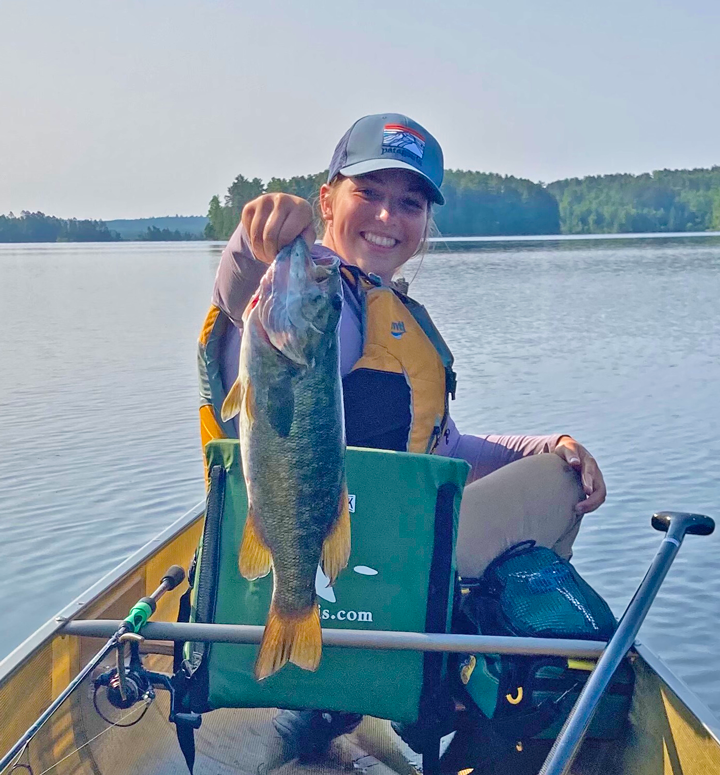 "Walleye - Walleye anglers continue to find walleyes in water 12ft or less. Shallow boulder flats or on top of sunken islands, has been the locations to look for. Reports of walleye throwing up crawfish has also been reported by several anglers. As a result, orange jigs and half a crawler have been very effective. Anglers are also catching walleyes with slip bobbers, spinner rigs and trolling large minnow baits over shallow flats.
"Walleye - Walleye anglers continue to find walleyes in water 12ft or less. Shallow boulder flats or on top of sunken islands, has been the locations to look for. Reports of walleye throwing up crawfish has also been reported by several anglers. As a result, orange jigs and half a crawler have been very effective. Anglers are also catching walleyes with slip bobbers, spinner rigs and trolling large minnow baits over shallow flats.
Smallmouth - Topwater fishing for smallies continues to be fantastic for bass anglers. Anglers continue to find bass on shallow boulder flats and around trees laying in the water. Classic smallmouth spots. Wacky worms, ned rigs and in-line spinners have also been very effective for bass anglers.
Panfish - Sunfish anglers have been finding active sunnies in shallow weed beds. Small leeches, angleworms and waxies fished under a bobber has been very effective. Crappie anglers have had a harder time finding crappies this last week. Reports of successful trips have been few and far between. Anglers should be looking for crappies to slide into weed beds during the evening hours. Small jig and twisters, beetle spins and crappie minnows fished under a bobber has been effective for anglers.
Lake trout - Lake trout anglers had a good week catching good number of trout. Anglers have been using trolling spoons and deep diving crankbaits, that dive to 20 feet plus. Leadcore will help pull these lures down to lakers. Lakers are being found between 20-80ft of water. — Arrowhead Outdoors, 218-365-5358
 Jeff Sundin June 20, 2023 "Mixing the Mix-Able"
Jeff Sundin June 20, 2023 "Mixing the Mix-Able"
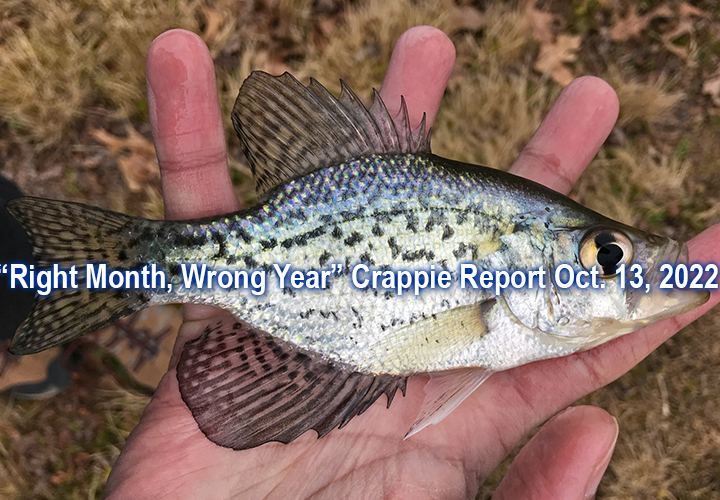 On Monday, I and my crew, the Beckers, were tentatively planning to fish on Upper Red Lake. The weather forecast, southeast winds, sometimes gusting to 20 MPH would have been fine 2 weeks ago when we could have settled in somewhere along the south shoreline. But when we met at the bait shop, Bill Powell gave us some advice, “most people are telling me that small fish are only thing left of the shoreline bite, especially on the south side. If you want larger fish, you might have to go out to the middle, and the wind looks pretty strong for doing that.” I agreed, so we scrapped plan A, in favor of plan B, mixed bag fishing.
On Monday, I and my crew, the Beckers, were tentatively planning to fish on Upper Red Lake. The weather forecast, southeast winds, sometimes gusting to 20 MPH would have been fine 2 weeks ago when we could have settled in somewhere along the south shoreline. But when we met at the bait shop, Bill Powell gave us some advice, “most people are telling me that small fish are only thing left of the shoreline bite, especially on the south side. If you want larger fish, you might have to go out to the middle, and the wind looks pretty strong for doing that.” I agreed, so we scrapped plan A, in favor of plan B, mixed bag fishing.
I headed for a lake where we fished once before, one where a typical day would be to get a handful of walleyes, lots of pike, numerous rock bass, plus a smattering of crappies, sunfish and largemouth bass. When we arrived, we found surface water temperatures ranging from 70 to 71 degrees. The surface was calm on the south end, but there was a stiff breeze, forming a hard chop on the water further north.
We started the day rigging up spinners, tipping them with fatheads and trolling the weed edges in a typically reliable area. Within a few minutes, Penny had caught a nice walleye and on the subsequent 2nd pass, she boated another one. That was a nice start, but nothing else happened there, so I moved further north and began checking out more territory.
From the time we dropped into the 2nd spot, until late afternoon, walleyes were either un-catchable, or un-findable, I saw fish on the graph that I believed they were walleyes but did not get those to bite. The rock bass, small perch, and crappies though, they were highly active. In fact, this was the most crappies I’d ever seen on this lake, but they were small compared to the ones we’ve caught before. Most of them were 7 to 8 inches long, occasionally we’d get a 9-to-10-inch fish and there were a few, maybe 2 or 3, 11-inch fish. We managed to sort out 14 or 15 keepers, they will be delicious, but the creel wouldn’t impress many “hard-core” crappie anglers.
We found and caught a lot of them using spinners, but I wondered what might happen if we spot-locked the boat and cast 1/8-ounce jigs tipped with ripple shads. That worked too, but I can’t say that it worked any better. So, it wasn’t long before we resumed trolling and catching.
 Toward the end of the day, I trolled over a non-descript weed flat in about 10 feet of water. The spot drives guys like me crazy because it doesn’t “look” like structure, there isn’t any hard drop off, hump of specific weed patch to follow, random patches of cabbage and coontail are the only features. The fish liked that spot though, we caught 3 more nice walleyes and a couple of keeper pike, along with 1 small largemouth bass, the only one we caught today.
Toward the end of the day, I trolled over a non-descript weed flat in about 10 feet of water. The spot drives guys like me crazy because it doesn’t “look” like structure, there isn’t any hard drop off, hump of specific weed patch to follow, random patches of cabbage and coontail are the only features. The fish liked that spot though, we caught 3 more nice walleyes and a couple of keeper pike, along with 1 small largemouth bass, the only one we caught today.
It's fair to say that the action was about as fast as it gets, as long as our lines were in the water, somebody was “getting bit” almost constantly. But at 71-72 degrees, I don’t think the water was quite warm enough to kick in all the potential species. We did not catch any sunfish, except for 1, largemouth bass either. Those species will kick into high gear soon but were likely still located on the shoreline today.
For me, the most optimistic part of our fishing trip was the presence of those small crappies. They added to support my theory about a strong, area wide, year class of up-and-coming slab crappies. In another season or 2, there should be plenty of fish in most of your favorite crappie fishing lakes. In case you missed it, I began reporting about the strong year class of crappies last fall, so check out the archive from October 13, 2023, for a deeper dive. And, I have the feeling that we’ll be re-visiting the crappie population reports often throughout this season as well.
Today, there’s more mixed bag fishing on tap, but I think we’ll be seeking a larger batch of keeper size pike. I’ll report in about that on Wednesday morning. ![]() — Jeff Sundin 218-245-9858 or EMAIL
— Jeff Sundin 218-245-9858 or EMAIL
 Jeff Sundin June 19, 2023 "Relaying the Relay-Able"
Jeff Sundin June 19, 2023 "Relaying the Relay-Able"
 "The fishing trip that I and the Hippie Chick had planned for yesterday hit a snag and didn’t happen. This is one of Susan’s on call work weeks, and with the boat loaded, us ready to drive away, her work phone started ringing. The project she got involved with promised to be time consuming, so we reasoned that staying close to home was a priority.
"The fishing trip that I and the Hippie Chick had planned for yesterday hit a snag and didn’t happen. This is one of Susan’s on call work weeks, and with the boat loaded, us ready to drive away, her work phone started ringing. The project she got involved with promised to be time consuming, so we reasoned that staying close to home was a priority.
As it happens, we were lucky to be around the house anyway because my “social calendar” got sort of busy. Father’s Day greetings from all our kids, along with the chance to wrap up some gardening projects already had me smiling. But my favorite youngest child Katie set the bar high when she arranged for a special, personalized celebrity video greeting for me. So, who offered this personal greeting? The Motor City Madman himself, Ted Nugent and it even included, at Katie’s request, Uncle Ted playing guitar licks, just for me. I’ve never heard of such a thing, but it was cool!
Back to work this morning, but without a fresh, firsthand fishing report. I might as well clear a couple more reader questions, leftover from last week’s email debacle. ![]() — Jeff Sundin 218-245-9858 or EMAIL
— Jeff Sundin 218-245-9858 or EMAIL
 Reader Question June 18, 2023 "What Kind Of Cane Poles Are You Using?"
Reader Question June 18, 2023 "What Kind Of Cane Poles Are You Using?"
Q) "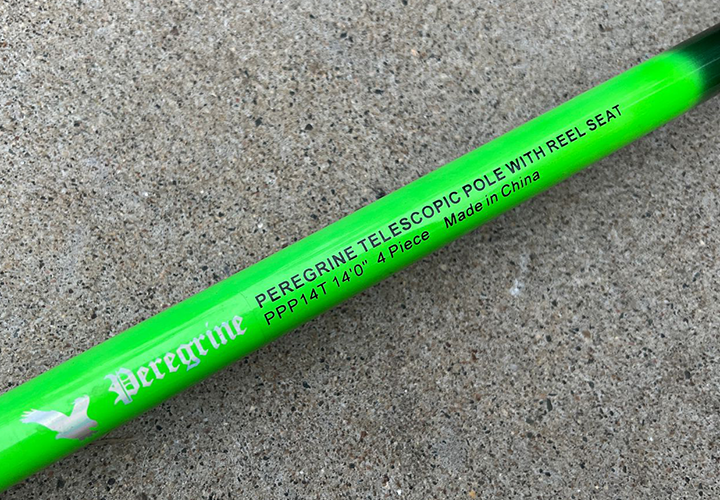 Regarding my report from June 4, 2023, "Fun (in the bulrushes) With Dick and Paul MMXXIII"
about using telescoping fiberglass “cane-poles” for fishing shallow cover on Lake Winnie, Chris Fosse wrote, “Hi! Do you have cane pole recommendations? Like how long and what (brand) do you have? Want to try it!”
Regarding my report from June 4, 2023, "Fun (in the bulrushes) With Dick and Paul MMXXIII"
about using telescoping fiberglass “cane-poles” for fishing shallow cover on Lake Winnie, Chris Fosse wrote, “Hi! Do you have cane pole recommendations? Like how long and what (brand) do you have? Want to try it!”
A) Chris, as a kid, we used cane poles almost exclusively and I remember having a blast fishing with them. One day, fishing on Cutfoot for panfish, I witnessed 2 men using them to catch sunfish in the lily pads. They were cleaning up on nice size sunnies, and I was re-living my youth watching them. That’s when I decided to add the telescoping poles to my arsenal.
I’m not sure if there are any “high-end” models of cane poles even available, I didn’t shop very much. The ones I bought are not fancy or expensive, they’re called Peregrine, and I bought them from Capra’s Sporting Goods in the Twin Cities for about $25 each. At the time, Capra’s was sold out of the longest model, 16 feet, I think and if I was buying them today, I’d try to get the longest ones available. But I was working at the Northwest Sportshow at the time, and wanted mine right away, so I settled for 14-foot poles. I didn’t think about it at the time, but these feature a reel seat, which turns out to be incredibly useful! I’ve been amazed at how well they cast and at times, this comes in handy.
Using the telescoping poles takes some getting used to, but once you get comfortable with them, I think you will have a blast fishing with them. ![]() — Office Cell Call or Text 218-245-9858 or EMAIL
— Office Cell Call or Text 218-245-9858 or EMAIL
 Reader Comments June 19, 2023 "Do Perch Eat Zebra Mussels?"
Reader Comments June 19, 2023 "Do Perch Eat Zebra Mussels?"
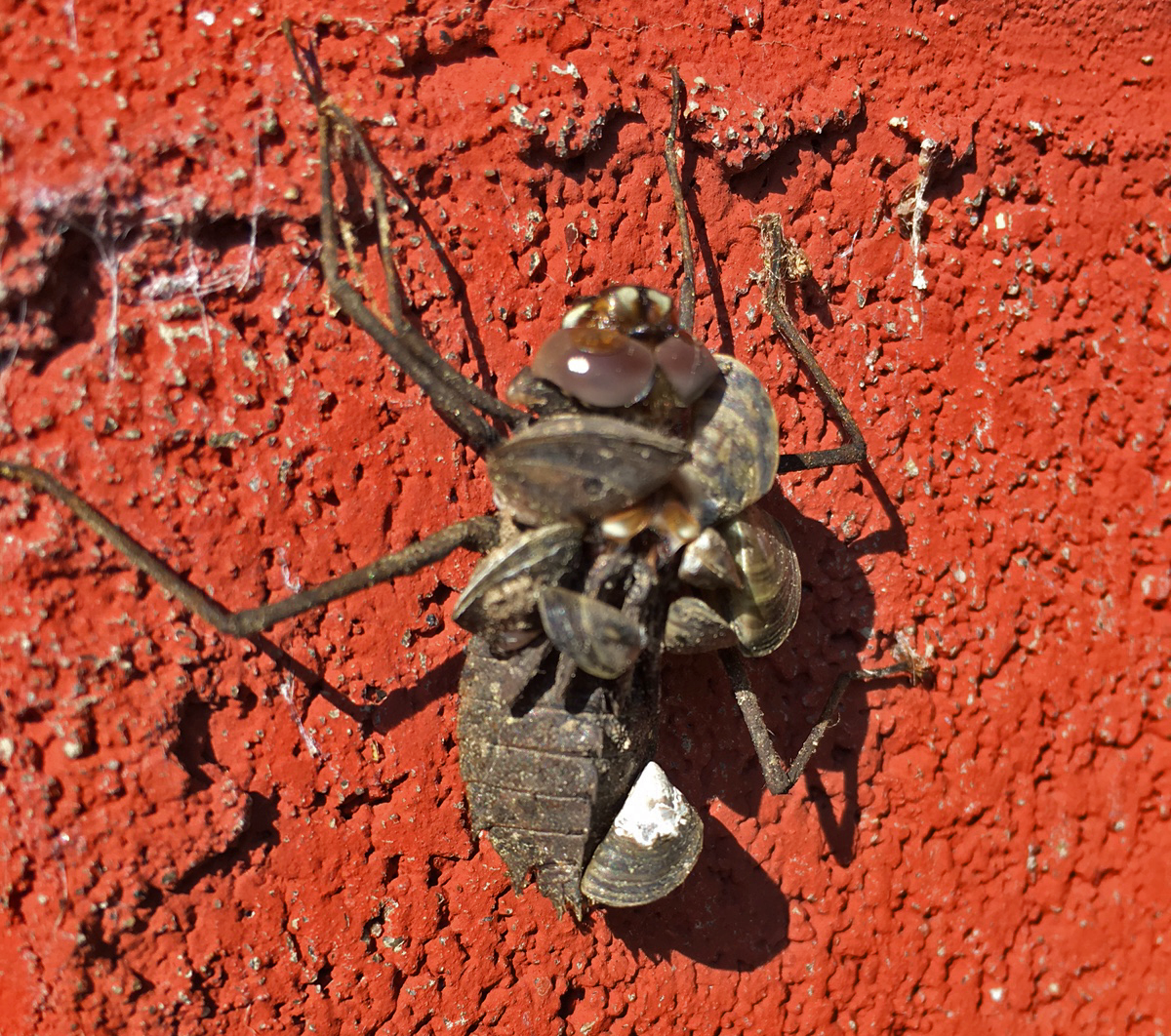 Regarding yesterday’s reader question about whether perch eat Zebra Mussels or not, retired DNR Big Lake Specialist Gerry Albert wrote. “Hi Jeff, just read your Q and A regarding zebra mussel in fish stomachs. I have seen and heard of Zeebs in Winnie fish stomachs for a while. This confused me but this year the answer may have shown itself. Zeebs attach to any hard surface including crayfish. This year I have cleaned several fish with undigested crayfish in their stomachs. Those crayfish had live zebra mussels attached to their shells. Just my observations.”
Regarding yesterday’s reader question about whether perch eat Zebra Mussels or not, retired DNR Big Lake Specialist Gerry Albert wrote. “Hi Jeff, just read your Q and A regarding zebra mussel in fish stomachs. I have seen and heard of Zeebs in Winnie fish stomachs for a while. This confused me but this year the answer may have shown itself. Zeebs attach to any hard surface including crayfish. This year I have cleaned several fish with undigested crayfish in their stomachs. Those crayfish had live zebra mussels attached to their shells. Just my observations.”
Shortly after receiving Albert’s message, we followed up by telephone. During the conversation, I recalled some photos that I posted in a June 2016 fishing report. Dragonfly nymphs, like crawfish, also have a hard shell and we have seen zebra mussels attached to those as well. The photo from Sand Lake in Itasca County shows mussels attached to one of them. I looked up photos of zebra mussels attached to crawfish and found numerous examples on various scientific research sites.
We know for sure that perch, walleyes, and other fish species love to eat crawfish. So, if a crawfish has Zeebs attached to it, we could assume that the fish did not select the zebra mussel as a meal but got them as a bonus for eating the crawfish. It’s not scientifically proven, yet, but when you think about it, Alberts anecdotal observations makes sense. ![]() — Office Cell Call or Text 218-245-9858 or EMAIL
— Office Cell Call or Text 218-245-9858 or EMAIL
 Reader Question June 18, 2023 "Where Have All The (Leech Lake) Walleyes Gone?"
Reader Question June 18, 2023 "Where Have All The (Leech Lake) Walleyes Gone?"
![]() NOTE: The email glitch that I wrote about a few days ago appears to be resolved. For everyone who did not get an email reply from me over the past few weeks, I apologize again and I’m thankful for your patience. Catching up with some of the delayed reader questions and comments will take a little time, but we’ll get to all of them, let’s get started.
NOTE: The email glitch that I wrote about a few days ago appears to be resolved. For everyone who did not get an email reply from me over the past few weeks, I apologize again and I’m thankful for your patience. Catching up with some of the delayed reader questions and comments will take a little time, but we’ll get to all of them, let’s get started.
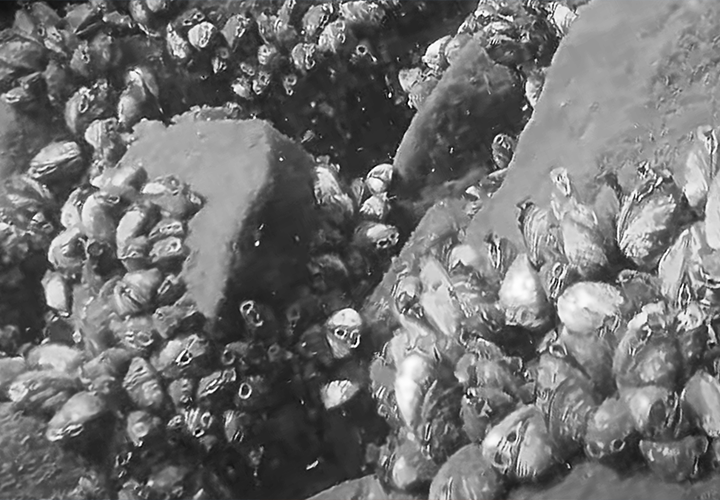 Zebra Mussels and how they impact walleye fishing was on Randy David’s mind when he wrote,
Zebra Mussels and how they impact walleye fishing was on Randy David’s mind when he wrote,
Q) “I live near Battle Point on Boy Bay, Leech Lake. I have been fishing on the east side of Leech Lake for over 30 years.
"Today, I witnessed something that I had never seen before. I caught 11 keeper perch, and when cleaning them they were full of zebra mussels. I had heard of certain sunfish consuming them but not Perch. I am not sure if this is good, bad, or insignificant. I wonder if you have heard of this or experienced it yourself. Any thoughts or comments?"
"Having fished this east side of Leech for so many years my neighbor and I are really struggling with consistent catches of all species of fish. The techniques of the past are no longer working for us. We know the extremely clear water is a new factor to deal with. At times it seems like something is seriously wrong with the lake and fish populations seem way down. Almost like the early 2000s. A testament to this might be the lack of fishing in the bay and even the main lake here on the east side. Most days you can count boats out fishing on one hand. Definitely concerning! You can certainly share my comments. It will be interesting to hear if anyone else has experienced this.“
A) Randy, your word “concerning” sums up everything about Zebra Mussels from A to Z, and there’s been plenty of it to go around. In the early days, when” Zeebs” were first being discovered in Minnesota lakes, their presence was largely thought to be a death sentence for some of our most beloved fishing lakes. Luckily, the worst of the gloom and doom scenarios haven’t played out in most Zebra Mussel infested lakes. That said, they certainly have forced anglers, especially walleye anglers into adapting to the changing water clarity, habitat, and fish location.
Your concern that walleye populations may be down in Leech Lake is understandable, but not likely “the problem”. Walleyes are still there, in fact the population remains strong, but walleye locations, feeding patterns and presentation preferences have changed dramatically. Clear water, especially on bright, calm days, force walleyes into deeper water, or into heavy cover where they can hide in the shadows. When an angler attempts to move over them, they disperse quickly, so scanning structure with conventional graphs or flashers has become virtually useless. That’s why forward-facing sonar has become so popular on Leech Lake, and others like it.
One friend of mine, a very good walleye fisherman and tournament angler described it to me this way. “I scanned the lake for hours trying to locate a school of walleyes, but never marked more than the occasional single on the screen. The first time I ever used my panoptix unit, I was amazed not only by how easy it was to locate fish, but by how many of them there were.” The more we drilled into the conversation, the more he convinced me that what on the surface looked like a dead sea, was a lake teaming with walleyes.
“Old school techniques” like drifting, vertical jigging and flat line trolling have become much less effective, especially on calm days or under bright conditions. One way we could adapt is to fish at night, or during the crepuscular periods when light levels are low, and walleyes become active. Folks who want to fish for walleyes during the daytime need to adjust to the changes in walleye behavior.
Knowing that walleyes living in clear water have become extraordinarily “boat shy”, better anglers have developed specialized presentations. They locate fish, stop the boat, then cast lures or live bait toward the fish to entice strikes. I’m not making a judgement about whether forward-facing sonar presentations are necessarily “good” for fishing. But this IS THE WAY that many modern anglers are fishing, and every day, I see more folks fishing with these tools in use. A half hour search on some of the so-called social media sites will reveal anglers showing off great walleye catches, not only on Leech Lake, but many of the other Zebra Mussel infested waters.
Personally, I have not “pulled the trigger” on purchasing any forward-facing sonar unit. But like you, I struggle these days on lakes like leech, where the presentations I’m familiar with have lost their luster. Eventually, I’ll have to do it, but for now, I shy away from lakes that cause me problems. Instead of struggling with calm water or bright days, I just wait for the wind and rain to provide cover and allow me to use the familiar techniques that my customers are accustomed to, and familiar with.
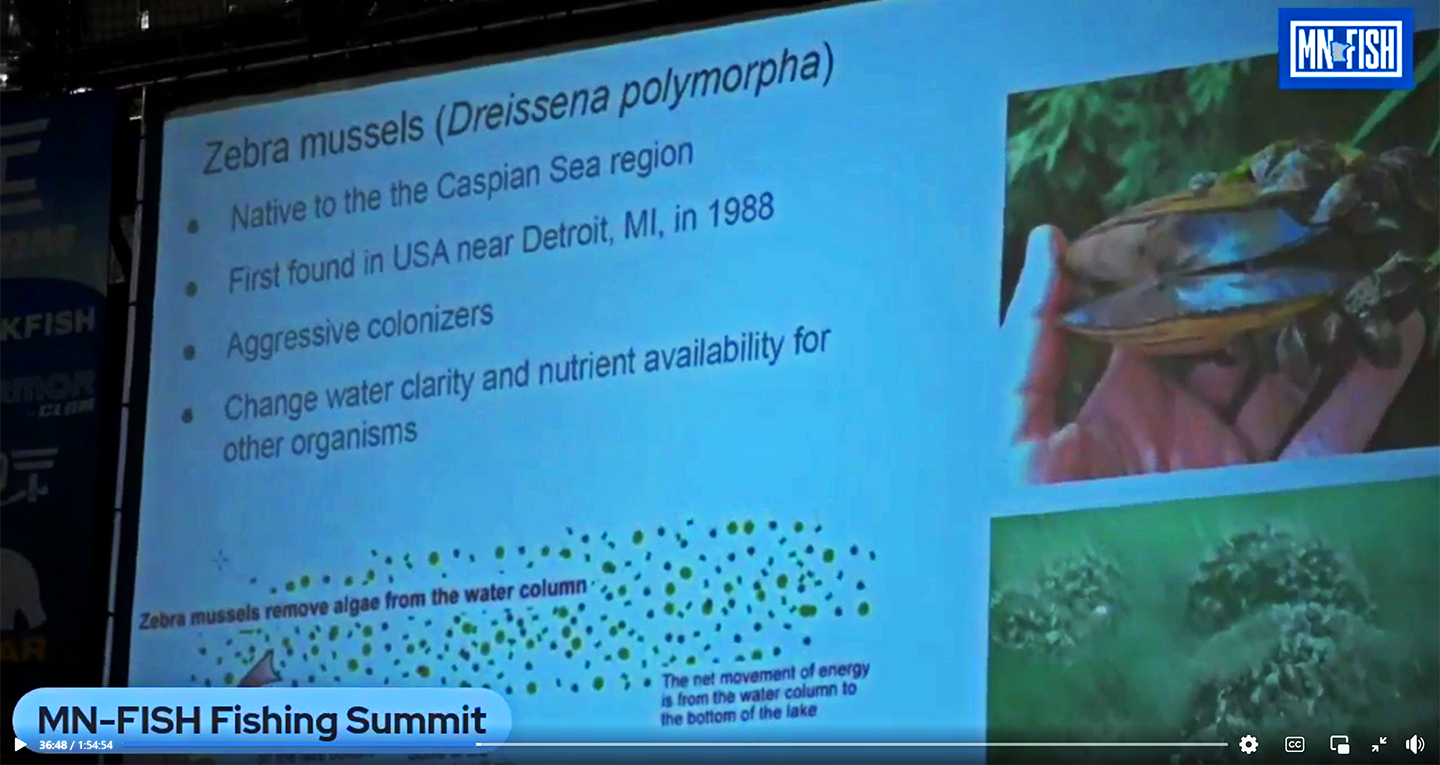 Using forward-facing sonar to solve the boat shyness problem is not the only solution, it's just one that I'm familar with today. Adaptations to changing conditions will lead in more directions, of that I’m certain. But knowing how walleyes respond to changing conditions will be key to their development. Recently, studies about how walleyes respond to the presence of Zebra Mussels have been undertaken. At the 2023 MN-FISH spring summit meeting, University of Minnesota's Dr. Gretchen Hansen gave a presentation on the subject. The information will help all of us learn more about the impacts of zebra mussels on Minnesota lakes and I would suggest viewing the video. To find it, follow this link to >> The Impact of Zebra Mussel on Walleye Populations and then scroll into 36.13 on the video, that is where the Zebra Mussel presentation begins.
Using forward-facing sonar to solve the boat shyness problem is not the only solution, it's just one that I'm familar with today. Adaptations to changing conditions will lead in more directions, of that I’m certain. But knowing how walleyes respond to changing conditions will be key to their development. Recently, studies about how walleyes respond to the presence of Zebra Mussels have been undertaken. At the 2023 MN-FISH spring summit meeting, University of Minnesota's Dr. Gretchen Hansen gave a presentation on the subject. The information will help all of us learn more about the impacts of zebra mussels on Minnesota lakes and I would suggest viewing the video. To find it, follow this link to >> The Impact of Zebra Mussel on Walleye Populations and then scroll into 36.13 on the video, that is where the Zebra Mussel presentation begins.
So, Randy, the fish are there and your best days of catching walleyes on Leech Lake could easily be ahead, and not behind you. As we learn more about Zebra Mussels, other invasive species too, we're liable to learn that walleyes are a lot more adaptable than we thought. They seem to flourish, albeit in ways different than we've known before. Now the question will be how adaptable are we? By the time we figure out how to cope with this current phase of evolution, another one will be under way and we'll have a whole new set of problems to solve.
Regarding the Yellow Perch, and the Zebra Mussels that you found in their stomachs, I'll have to do some more research. I'm not aware of any studies that suggest perch using them as a food source. Instinctively, my first thought is that they might have picked them up as a byproduct of feeding on something else, crawfish or maybe an insect hatch. I'll run your question by some fo the fisheries biologists that I know, and maybe can provide a more extensive update next week.
Today, I have the day off because it's some sort of a holiday. So, I'm hoping to celebrate it with the Hippie Chick by exploring a lake that I haven't fished for a long time. We'll call it a busman's holiday, after all, there's no harm in combining work with a little pleasure, right? We'll let you know what we figure out tomorrow. Have a fabulous day everybody! ![]() — Office Cell Call or Text 218-245-9858 or EMAIL
— Office Cell Call or Text 218-245-9858 or EMAIL
 Ely Area, Arrowhead Outdoors Fishing Report June 14, 2023
Ely Area, Arrowhead Outdoors Fishing Report June 14, 2023
 "Walleye - Walleye fishing cooled off this last weekend thanks to good cold front that dropped water temps 10 degrees. As a result, walleyes dropped to 15-25 feet of water, just off those shallow flats anglers were catching them just days before. Minnows really came back into play for anglers. Simple jig and minnow, worked right on top of those inactive walleye was effective. Pink/white, blue/white and gold remain popular colors for walleyes. Angler have now started reporting walleyes out on sunken islands.
"Walleye - Walleye fishing cooled off this last weekend thanks to good cold front that dropped water temps 10 degrees. As a result, walleyes dropped to 15-25 feet of water, just off those shallow flats anglers were catching them just days before. Minnows really came back into play for anglers. Simple jig and minnow, worked right on top of those inactive walleye was effective. Pink/white, blue/white and gold remain popular colors for walleyes. Angler have now started reporting walleyes out on sunken islands.
Smallmouth - Smallmouth bass continue to be very active and aggressive for anglers. Topwater continues to be very popular among bass anglers. Ned rigs and in-line spinners are also accounting for a large number of bass for anglers. Shallow boulder flats, points and around islands, continue to be areas to focus efforts for bass. Anglers have noticed that crawfish are shedding their shells in the shallows right now and bass are focused on them.
Panfish - Weed beds have developed quickly on area lakes and panfish are being found in weed beds or on the weed lines. Angleworms and waxies, fished under a bobber, in those weed beds has been the way to catch sunnies. Crappies are being found just off weed lines during the day, then in the weed beds during the evening hours. Jig/twister or crappie minnows fished under a bobber has been very effective on crappies.
Stream Trout - Thanks to the recent cool off, trout have come up in the water column and fishing has improved for anglers. Anglers fishing from shore have been catching trout with small spoons and spinners. Anglers fishing from a boat continue to catch good numbers of trout trolling small minnow baits behind cowbells, about 10-15 feet down." — Arrowhead Outdoors, 218-365-5358
 Lake of the Woods, LOW Tourism June 13, 2023
Lake of the Woods, LOW Tourism June 13, 2023
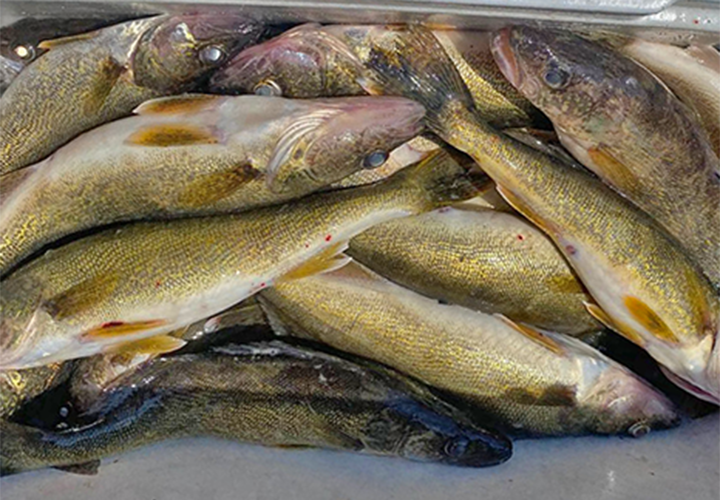 "Reports about a fantastic week of fishing on Lake of the Woods are common. Walleye anglers are coming in with lots of limits of "eaters" and also with some great photos of larger, fish that were released along the way. Most walleyes are being caught in 7 to 25 feet of water, surface temperatures in the low-to-mid-70s.
"Reports about a fantastic week of fishing on Lake of the Woods are common. Walleye anglers are coming in with lots of limits of "eaters" and also with some great photos of larger, fish that were released along the way. Most walleyes are being caught in 7 to 25 feet of water, surface temperatures in the low-to-mid-70s.
One technique that has been deadly for walleyes this week is using a night crawler harnesses; they are catching a lot of fish right now. Using a size 2 hook snelled spinner with a night crawler paired with a 2 ounce inline sinker or bottom bouncer. For the spinner blade, try a small, size 2 to a medium size 4 blade in gold, or glow, red, orange, pink or glow-white.
Some anglers are using a minnow on their spinner rig with success. Jigging with a minnow is still catching a lot of fish, especially when on structure. Leeches are just starting to work for walleyes, and will get better as the hot summer weather continues. There are also good reports from anglers trolling crankbaits both in the shallows along shore and in deeper depths.
 Great pike reports, with many nice fish being caught by unsuspecting walleye anglers.
Great pike reports, with many nice fish being caught by unsuspecting walleye anglers.
On the Rainy River, anglers are finding some nice walleyes in many of the traditional walleye haunts such as current breaks, holes and rocky areas. Some fish are showing up in shallow flats as well.
Try pitching a jig and minnow to high probability areas with structure or a current break. To find and catch fish spread out on a flat or along a break, troll crankbaits or spinners with crawlers. The Rainy River has some incredible smallmouth bass fishing. Target feeder rivers, bridges, and areas with rocks. For pike, weed beds, bays and feeder rivers to the Rainy River. The sturgeon season opens again July 1st.
Up at the Northwest Angle, walleye fishing continues to be excellent. Most are jigging with a minnow or plastic on underwater points, neck down areas, flats with moving water and edges of reefs. With the water warming, spinners and crawlers are coming on strong. They are a great way to cover water and put your bait in front of a lot of fish.
Caught plenty of walleyes and want to mix it up? Try casting bays or areas around points. Spinnerbaits, crankbaits and swimbaits are great all around lures that will catch a mixed bag. The muskie season opens June 17, 2023." — Lake of the Woods Tourism, (800) 382-FISH
 Jeff Sundin June 12, 2023 "Responding to the Respond-Able"
Jeff Sundin June 12, 2023 "Responding to the Respond-Able"
 So, here’s a common scenario. Sometime recently, you were reading one of the fishing reports of FishRapper and saw something interesting. Curious for more information, or maybe interested in making your own contribution, you followed the email link, sent me an email, and waited for me to respond. For most of you, communication was swift, most of the time, responses come within a day, sometimes your comments were even featured in the fishing reports.
So, here’s a common scenario. Sometime recently, you were reading one of the fishing reports of FishRapper and saw something interesting. Curious for more information, or maybe interested in making your own contribution, you followed the email link, sent me an email, and waited for me to respond. For most of you, communication was swift, most of the time, responses come within a day, sometimes your comments were even featured in the fishing reports.
For some folks though, that scenario hasn’t played out, email messages have been sent, but have not been answered. Why is that? It’s because you have a Gmail account. Google allows me to receive messages from you, and I have. But when I respond to anybody’s Gmail messages, they are kicked back to me as undeliverable. Google will not allow you to receive email responses from me. Despite writing these reports for almost 20 years, and despite having nearly a quarter million users, Google apparently doesn’t believe that I’m real, so they’re protecting you from receiving email messages from me.
They say that there is a fix, that I must “authenticate” all my email accounts and that once I do, Google will trust me. I believe them, but I’m a fishing guide, not a computer whiz and my only problem is that I haven’t been able to figure out how to make the authentication work.
I will eventually get this fixed, but until I do, I have a workaround for Gmail users. If possible, please send your messages and comments via text message to the office line, 218-245-9858. Texts are not as handy for me, especially when I’m working, because the only time I have to answer them is during the wee hours of morning and I’m cautious about texting folks when they’re sleeping. That said, if you do text me, at least I can and will respond, eventually.
So, I apologize to all of you who do use Gmail and assure you that are not being ignored, I simply have not been allowed to reply. As soon as I can get this fixed, I will. ![]() — Jeff Sundin 218-245-9858 or EMAIL
— Jeff Sundin 218-245-9858 or EMAIL
 Jeff Sundin June 8, 2023 "Noting the Note-Able"
Jeff Sundin June 8, 2023 "Noting the Note-Able"
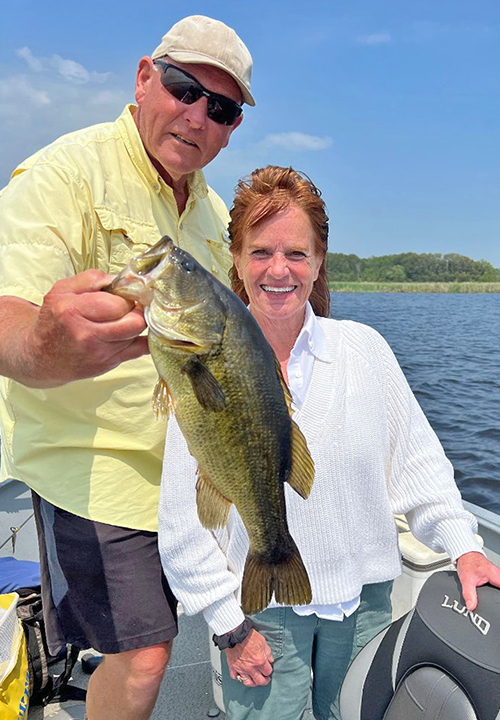 Caused by a week-long stretch of calm, sunny, and hot weather, I had been reporting incredibly high surface temperature readings. On most lakes, crossing the 80-degree mark was the norm and on some shallow, dark water lakes and flowages, 82 to 84 degrees we not uncommon. Beginning on Tuesday, a welcome turnaround occurred when breezy conditions arrived. The “walleye chop”, combined with cooler air temperatures helped mix the hot surface water with cooler, sub-surface water. On Wednesday, my graph revealed surface temperatures had fallen into the 71-to-72-degree range. More moderate to be sure, but still warm when compared to past seasons.
Caused by a week-long stretch of calm, sunny, and hot weather, I had been reporting incredibly high surface temperature readings. On most lakes, crossing the 80-degree mark was the norm and on some shallow, dark water lakes and flowages, 82 to 84 degrees we not uncommon. Beginning on Tuesday, a welcome turnaround occurred when breezy conditions arrived. The “walleye chop”, combined with cooler air temperatures helped mix the hot surface water with cooler, sub-surface water. On Wednesday, my graph revealed surface temperatures had fallen into the 71-to-72-degree range. More moderate to be sure, but still warm when compared to past seasons.
The long-term impact of the fast rise in water temps is unknown, but for anglers, the immediate impact could be viewed as positive. Algae blooms are accelerated, providing an increased supply of food for recently hatched gamefish fry; this could be helpful in providing a strong year class of walleye from 2023. The warm water and calm seas “should have” been good for nest building spawners like crappies, sunfish, and bass too. Crappies came into the shallows and spawned quickly, now there are sunfish, bass and rock bass following suit. So, this doesn’t guarantee that we can count on a strong year class for panfish in 2023, but it is encouraging.
Anglers are enjoying the immediate impact of the warm water too. My customers, for example, have caught some nice bass and panfish while we’ve been in pursuit of walleyes. Above, the photo of an incidental catch by Janet Christensen (above left) shows a big Largemouth Bass that struck her spinner-and-minnow while we were trolling for walleyes on Winnie this past Tuesday. The image (below right) shows Brian Shields with the big Smallmouth Bass he caught on a jig and minnow while we were fishing for walleyes on Wednesday. So, my favorite period, the “mixed bag” fishing season appears to be starting early this year, I love that!
On the flip side, warm dry weather causes some concerns too. Frequent contributor, Travis Verdegan, Predictive Services Coordinator in the 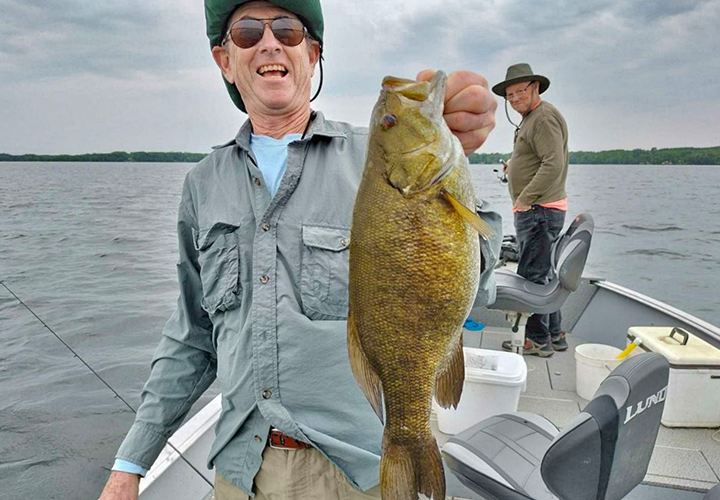 wildland fire section of the DNR wrote; “We've been seeing abnormally high fire potential for this time of year. Fishermen and firefighters both are heavily impacted by the weather, and it appears likely that we will be impacted by some abnormally dry conditions this summer.” While there is no way to be certain, Verdegan speculated that if present conditions persist, it could develop into full blown drought like we saw in 2021. “The big difference between this year and that one was the winters we had. That'll make the timing and sequence of events different.” Verdegan concluded.
wildland fire section of the DNR wrote; “We've been seeing abnormally high fire potential for this time of year. Fishermen and firefighters both are heavily impacted by the weather, and it appears likely that we will be impacted by some abnormally dry conditions this summer.” While there is no way to be certain, Verdegan speculated that if present conditions persist, it could develop into full blown drought like we saw in 2021. “The big difference between this year and that one was the winters we had. That'll make the timing and sequence of events different.” Verdegan concluded.
Water levels in most lakes around our region generally remain good, but in the past week, I have seen them dropping. At the boat ramps, weeds and debris are making trailer clean up a chore. Filamentous Algae in particular, the slimy moss-like substance that sticks to everything has forced me to run the pressure washer almost every day this week. Other loose debris has blown into landings too, so we’ll all need to take care when launching and loading our boats from here on out.
Like they say, “it all depends on the weather”. So, rather than speculate now, we’ll keep our eyes on conditions and provide frequent updates in upcoming reports.
A few weeks ago, I offered some guidance in reference to catching and releasing walleyes in lakes that have protected slot regulations. At the time, I mentioned that in some lakes, there were a lot of fish that came close to the protected slot sizes and that we should take extra care when measuring our walleyes. That advice was good at the time, but now it’s even more important because in recent days, I’ve observed numerous walleye that were “ULTRA CLOSE” to their protected slot sizes.
As tempting as it can be to harvest fish that “almost touch the line”, great care must be taken to be sure that the measurement is accurate. Awareness of the situation has been heightened recently because on some lakes in our region, folks have noted that there are some “slot fish” showing up at certain fish cleaning stations. In the past, I’ve read accounts about fish the either stretch or shrink a little bit once they’re placed in the livewell or ice chest and I think I’ve even observed it a time or two.
Obviously, you can handle it any way you want to, but for me, the safety gap is officially widening. I’m instituting a boat policy that any fish within ½ inch of its respective protected slot size on a given lake. I want to see a nice wide gap between the pinched tail and the safe line on my ruler. The same will be true for lakes like Big Sandy, that have “harvest slots” instead of protected slots. There, the minimum size for a keeper is 14 inches and the maximum size is 18 inches. Following my own advice, the boat rule there would be 14-1/2 to 17-1/2 inches for our harvest size.
 Forward facing sonar is fast becoming “the hot topic” of conversation among folks in the fishing industry, angling organizations, and regulatory agencies.
Forward facing sonar is fast becoming “the hot topic” of conversation among folks in the fishing industry, angling organizations, and regulatory agencies.
Yesterday, Robert Klocker emailed; “Interesting article on forward facing sonar on open water fishing. Coincidently I was on Leech Lake during the Walleye tournament this past weekend. We were not participants of the local tournament, but we were part of the ALS fund raising tournament. We started fishing at 7:00 am and found a school of walleye with side imaging. About 15 minutes later a tournament boat pulled into area we were fishing. I would say 100-150 ft away. They immediately deployed their forward sonar and started scanning. Within minutes they locked onto the school of fish and pinpointed the fish. We watched as these fishermen were able to pick off these fish with ease by pointing to exact location of each fish.
I’m not criticizing these fishermen by any means. As a matter of fact, I have forward faced sonar (that) I use ice fishing. Perhaps we as sportsman need to ask ourselves a question. Is it really sporting to use this technology to harvest fish? Maybe we limit its use to catch and release only? I fear (for) the future of quality fishing. Over my 50 years of fishing, I’ve seen technology evolve and nothing has impacted fishing like this forward-facing sonar.”
Note: This link provided by Klocker to the Dennis Anderson, Star and Tribune article may or may not work for you. If it does not, find the original article titled, "Does live sonar mean the end of fishing, or just the end of fishing as we know it?" in the outdoors section of the Star & Trib published on Friday June 2, 2023.
And for my take on the subject, you might enjoy reviewing my thoughts about live sonar within this February 20, 2023 article >> "Preserving Quality Sunfish and Crappies In Minnesota"
At the moment, I'm awaiting a fresh report from the folks at Bowen Lodge. It might be here time to publish this morning, but if not there will certainly be a fresh, comprehensive report from Lake Winnie and Cutfoot Sioux by tomorrow morning, so be sure to check for that. ![]() — Jeff Sundin 218-245-9858 or EMAIL
— Jeff Sundin 218-245-9858 or EMAIL
You Are Invited To Become A Duly Deputized Fishrapper Cub Reporter
 If you've been waiting for a gold engraved invitation to participate in the daily reports, then stop waiting and consider this your own personal invitation.
If you've been waiting for a gold engraved invitation to participate in the daily reports, then stop waiting and consider this your own personal invitation.
Helping your fellow fishermen and women stay abreast of fishing conditions in your area is good for everybody and it's easier than you think! You don't have to write a book, you don't have to share your secret fishing spots and you don't even have to mention your lake. But even a few words about general trends, seasonal patterns and local weather conditions can really help.
Be like me, become a duly deputized "Cub Reporter", it's good for fishing! Contact Us or if you prefer to be "social", Fishing Reports Minnesota, the Facebook counterpart to this page is open to the public, so you can post your own fishing update or just share a photo of a nice catch.
 Ely Area, Arrowhead Outdoors Fishing Report June 7, 2023
Ely Area, Arrowhead Outdoors Fishing Report June 7, 2023
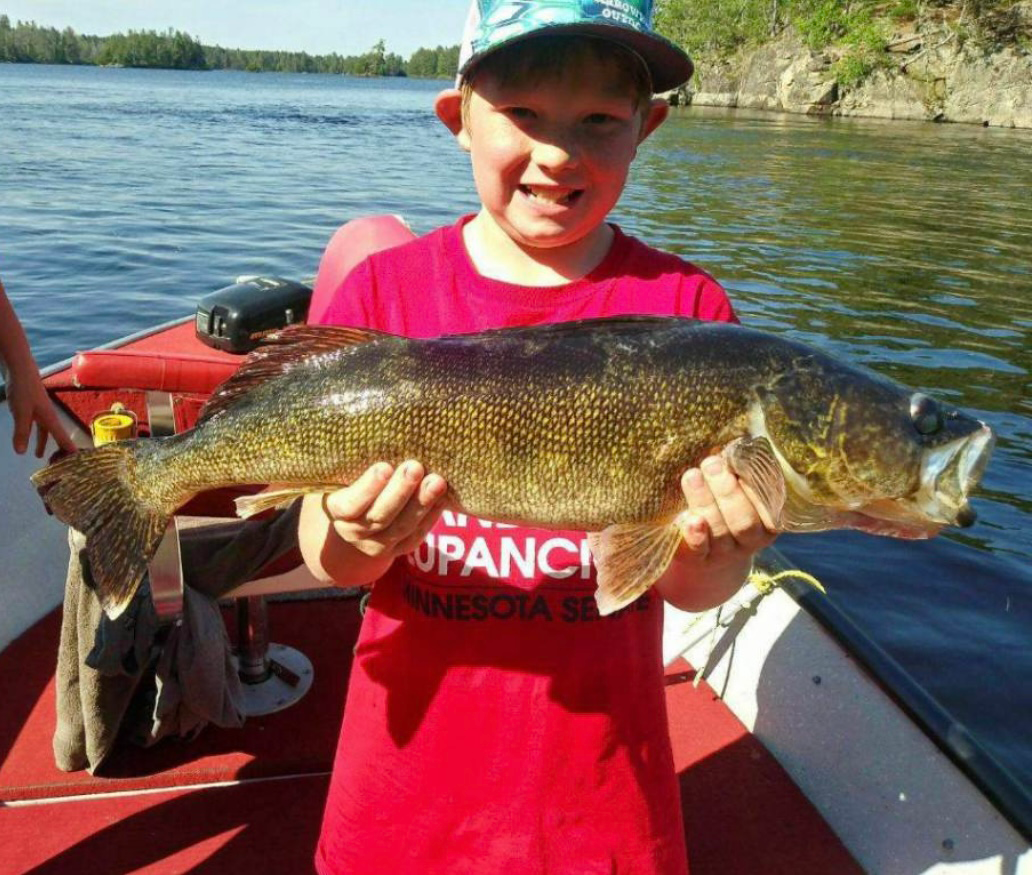 "Walleye - The skinny water walleye bite continues to be very hot! Walleyes continue to be found in water as shallow as 2 feet (not a typo). Anglers are having great success fishing leeches under a bobber, shallow running minnow baits and trolling slow death rigs. Shallow, wind blown flats, remain the best place to find these hungry walleye.
"Walleye - The skinny water walleye bite continues to be very hot! Walleyes continue to be found in water as shallow as 2 feet (not a typo). Anglers are having great success fishing leeches under a bobber, shallow running minnow baits and trolling slow death rigs. Shallow, wind blown flats, remain the best place to find these hungry walleye.
Smallmouth - With water temps as high as 83 degrees on some area lakes, the bass have largely wrapped up spawning. Topwater baits have quickly become the go to lures for bass anglers. Whopper ploppers, torpedoes, pop-r’s and hula poppers are all catching tons of smallies right now. Ned rigs and wacky worms are also accounting for their fair share of bass. Shallow boulder flats, in 10 ft if water and less is where you will find active bass.
Panfish - Thanks to the rapid warmup in water temps, panfish are being found in shallow bays looking to spawn or wrapping up spawning. Either way, worms, crappie minnows, waxies are all catching lots of panfish in the shallows. If the panfish have already spawned their location is a little different. These panfish are being found out on the weedlines. Small twisters and beetle spins are catching these fish.
Stream trout - Rainbows and brown trout are being caught on area stream trout lakes by trolling small crankbaits, spinner rigs and cowbells. Warm water temps have pushed trout down to 15-20 feet of water. This has resulted in many of the trout being found out over deeper water, cruising around, looking for a easy meal.
Pike - Warm temps have pushed out most of the big pike, from shorelines. Small pike have remained in the shallows and have remained very active. Spoons, spinnerbaits and large suspending minnow baits have been catching pike. Anglers have been working weedlines, river mouths and mouths of shallow bays, in 12 feet of water and less." — Arrowhead Outdoors, 218-365-5358
 Lake of the Woods, LOW Tourism June 7, 2023
Lake of the Woods, LOW Tourism June 7, 2023
 "Lots of limits of nice eating size walleyes were caught this week on Lake of the Woods. Anglers are also releasing plenty of fish in the protected slot, 19.5 - 28.0 inches, and catching a good number of trophy walleyes, over 28 inches.
"Lots of limits of nice eating size walleyes were caught this week on Lake of the Woods. Anglers are also releasing plenty of fish in the protected slot, 19.5 - 28.0 inches, and catching a good number of trophy walleyes, over 28 inches.
Water temperatures are about 73 degrees now and this means crawler harnesses have really kicked in this week. Using a 2 or 3 hook harness with a crawler teamed up with a weight or bottom bouncer of about 2 ounces is a nice combination and will catch fish. A tip when pulling spinners, keep just a couple of inches of crawler off of your back hook and pinch off the remainder. The walleyes will still hit your spinner rig and you will hook more. Some anglers are using a minnow on their spinner rig. Others, especially when on structure, are still jigging with frozen emerald shiners. Good reports on crankbaits as well, both along Pine Island and with lead core in deeper depths.
Walleyes are being caught around the lake with many still adjacent to shoreline structure, although with the warm weather, some fish will be transitioning to the big open mud flats of Big Traverse Bay. Walleyes are being caught in anywhere from 7 to 25 feet.
Good pike reports. Back bays and shoreline structure are holding good numbers of these aggressive feeders. Some big, 14 plus inch perch are showing up in walleye catches as well.
On the Rainy River, anglers fishing the river are finding small schools of eater walleyes in various locations. Current breaks, holes and rocky areas are great areas to start. Anchored up or slowly moving upstream with a jig and minnow is a go to technique. To find fish or catch fish spread out on a flat or along a break, troll spinners with night crawlers or crankbaits.
Smallmouth bass and pike showing up as they are in good numbers. For bass, target feeder rivers, bridges, and areas with rocks. For pike, weed beds, bays and feeder rivers to the Rainy River.
Up at the Northwest Angle, walleye fishing on both on the MN side and Ontario side of the border, has been super good. Working shoreline structure such as underwater points, neck down areas, flats with moving water and edges of reefs will reward anglers with walleyes.
A jig and minnow continues to be the go to bait. Much like the south end of the lake, spinners and crawlers are coming on strong and are a great way to present your offering to good numbers of fish. Also great reports for those trolling or casting crankbaits catching nice walleyes of all sizes. When fishing the NW Angle area, expect a variety of species. Smallmouth bass are hanging out amongst rocky points and shorelines. Pike are in bays and underwater points. The muskie season opens June 17, 2023" — Lake of the Woods Tourism, (800) 382-FISH
 Jeff Sundin June 6, 2023 "Fun With Dick and Paul MMXXIII"
Jeff Sundin June 6, 2023 "Fun With Dick and Paul MMXXIII"
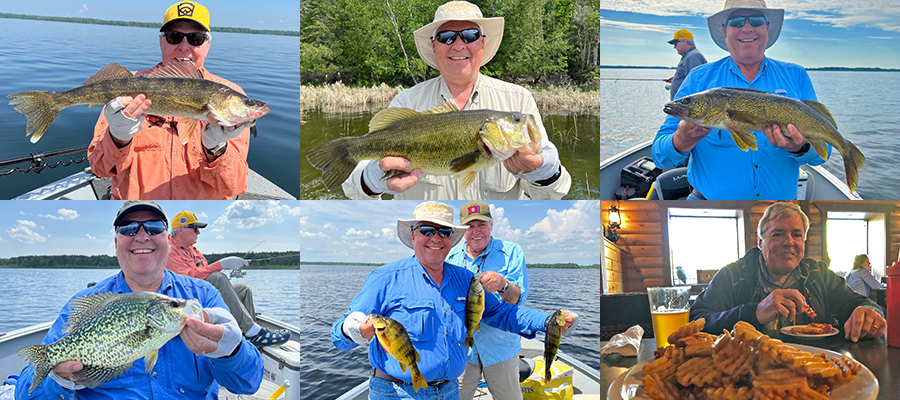 “Fun With Dick and Paul” MMXXIII Spring session is now in the history books. The trip overall was a good one and yesterday evening, we packed the boys’ cooler with limits of walleye and perch, half a limit of crappies and a pike for Dick to test out my blackening recipe.
“Fun With Dick and Paul” MMXXIII Spring session is now in the history books. The trip overall was a good one and yesterday evening, we packed the boys’ cooler with limits of walleye and perch, half a limit of crappies and a pike for Dick to test out my blackening recipe.
Perch, pike, and walleye patterns didn’t change much throughout the week, so perusing the archived reports will keep you up to speed. The new news today concerns crappies, their spawning runs and feeding patterns. I’d say that as of today, 90% of the crappies in this north central Minnesota region have completed spawning. Anglers who want to catch them now will need to adjust to “post spawn” locations and feeding patterns.
Today’s theme, crappie location and feeding patterns also ties into a reader question that came in yesterday evening. Alan Duit wrote;” Good afternoon. Your advice has put some crappies in the Fry pan for us. The biggest was just under 13.5 inches which was my new personal best. Caught a few other 11 inches. My question is (that) the crappies we have caught have all been (located) in the reeds shallow water, 1 at a time; no school of fish or anything like that. Are these just late spawners? Or just happen to be cruising through?” Thanks again, Alan.
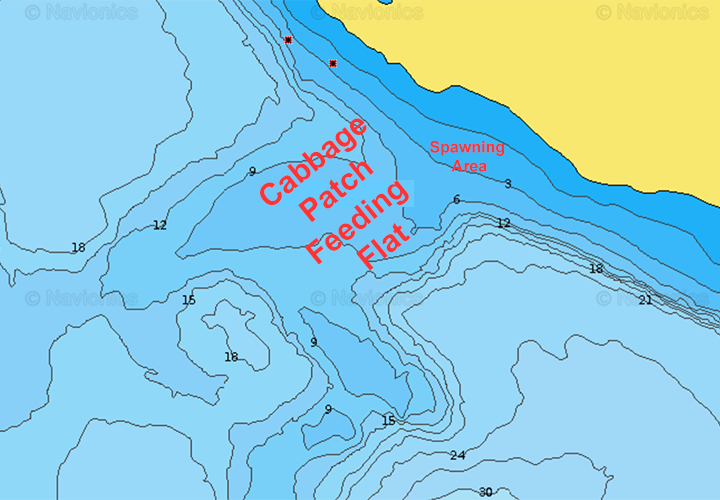 Once the spawning cycle runs its course, crappies seemingly disappear as they enter one of their most irksome feeding patterns of the open water season. The problem is not how to catch them, but rather when to catch them and the answer is when the mosquitoes are biting the best, so are the crappies. As crappies enter the “post-spawn” period during early summer, they become crepuscular feeders, most often feeding aggressively as they cruise along shoreline breaks or along weed edges during late evening and very early morning periods.
Once the spawning cycle runs its course, crappies seemingly disappear as they enter one of their most irksome feeding patterns of the open water season. The problem is not how to catch them, but rather when to catch them and the answer is when the mosquitoes are biting the best, so are the crappies. As crappies enter the “post-spawn” period during early summer, they become crepuscular feeders, most often feeding aggressively as they cruise along shoreline breaks or along weed edges during late evening and very early morning periods.
Most folks already know, or at least have a good idea of where crappies spawn. So, locating good feeding areas for the early/late feeding runs involves either finding cabbage patches on the flats, or steep breaklines located adjacent to the shallow spawning flats.
Cabbage patches are my personal favorite because sometimes crappies located int hem can be coerced into biting during the day, and for you Alan, the lake you’re fishing on now does happen to offer structure like that, illustrated in screenshot #1.
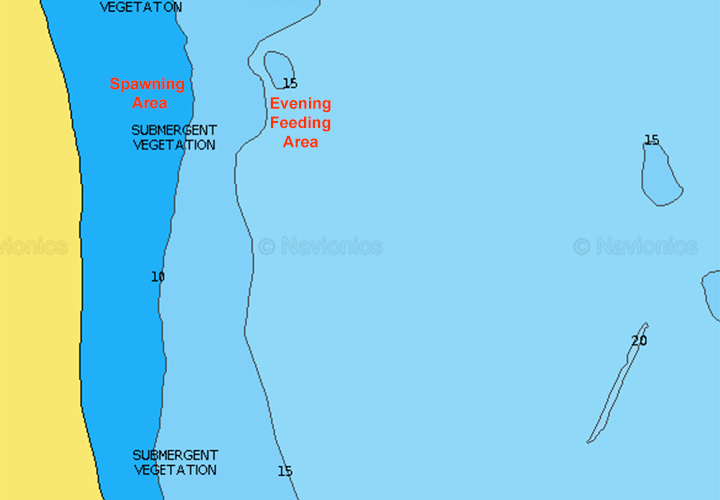 The alternative, fishing the steep shoreline breaks happens to fit the scenario of the lake where I fished yesterday. In past summers, we’ve lingered into the evening and caught crappies on the breakline adjacent to a well-known spawning area, illustrated in screenshot #2.
The alternative, fishing the steep shoreline breaks happens to fit the scenario of the lake where I fished yesterday. In past summers, we’ve lingered into the evening and caught crappies on the breakline adjacent to a well-known spawning area, illustrated in screenshot #2.
Presentations are straightforward, you could choose to anchor and fish using slip floats, troll with spinners, beetle spins or using soft plastic tails. In my opinion, crappies like movement and I prefer the action tails and spinners. That said, anglers all over America have caught tons of crappies using nothing more than a small minnow, on a plain hook, held in place with a split shot sinker, and suspended under a bobber.
Just remember the bug spray and get into position before the sun touches the treetops and you should be in business.
On the heels of a 6-day stint with Dick and Paul, it’s back to the “real world” for me. I’ll be fishing most single day trips this week, following up with you every morning to share whatever we learn. Have a fabulous day! ![]() — Jeff Sundin 218-245-9858 or EMAIL
— Jeff Sundin 218-245-9858 or EMAIL
 Jeff Sundin June 5, 2023 "Fun (in the heat) With Dick and Paul MMXXIII"
Jeff Sundin June 5, 2023 "Fun (in the heat) With Dick and Paul MMXXIII"
 Day 5 of “Fun (in the heat) With Dick and Paul” is now in the history books. This was the warmest of their trip so far, and also the 5th day that they never needed a jacket, rain coat or anything more than shirtsleeves and light pants.
Day 5 of “Fun (in the heat) With Dick and Paul” is now in the history books. This was the warmest of their trip so far, and also the 5th day that they never needed a jacket, rain coat or anything more than shirtsleeves and light pants.
In the report yesterday morning I mentioned that “the plan” for day 5 was to try fishing on one of the area’s clear, cool water lakes. I wrote, “We can sport fish for bass and while we’re at it, maybe stumble into some crappies that haven’t completed spawning yet.” Well, like a lot of my plans, this one changed before we ever left the Timber Lake Hotel parking lot. When Dick said that he’d prefer to catch perch, I decided the best idea was to follow up on a lead from one of my fishing buddies. Hoping that the perch he’d found a few days ago were still in the same areas, we drove to the lake that we’d find them.
When we arrived at the lake, surface water temperatures reflected the heat wave we’ve been having. During the morning, we noted temperatures in the 79-to-80-degree range and by late afternoon, they had risen to nearly 83 degrees; temperatures that don’t typically occur until mid-July. Also notable was that on our drive home, the instrument panel of my truck registered a reading of 100 degrees. Now I’m the first to point out that my truck in noticeably inaccurate, so I don’t trust that reading. But in relation to past readings, it is still the warmest one that I’ve ever experienced. No matter what the actual temperature was, my body was screaming at me that it was HOT!
Fishing for perch can be tricky, especially if you’re chasing a “hot tip” from friends. There are 2 things that can happen, both depending on what the schools of perch were feeding on whenever that fishing buddy found them originally. If they were feeding on minnows, they would most likely be gone, either having moved to wherever the minnows had been pushed or influenced by changes in wind and weather. But when perch are feeding on insects, they tend to stay in an area longer. Bug hatches usually take a few days, maybe more, to run their course, and the attractive power is enhanced.
Luckily for me, the perch we were targeting happened to be feeding on insects. I’m not sure which ones specifically because there wasn’t any evidence in the air, only dabs of dark black fish excrement on the fish themselves. Typically, a midge hatch will hold the perch’s attention, but there are other bugs, less easily identified that will do the same thing.
I didn’t find the perch right away because my first pre-conceived notion was wrong. I expected to find the perch in cabbage weeds and knew some likely spots to check out. But the cabbage we fished hosted only pike, not perch, so that search failed. The next idea was to move onto the lake’s shallow, weedy flats. The combination of coontail and northern milfoil makes these flats un-fishable during mid-summer. But during spring and early summer, the newly emerging plans are still low enough in the water column to allow access for certain presentations. Trolling spinners works, and that’s what we did yesterday. Sometimes jigs and minnows suspended below bobbers is a better idea. If schools of perch seem to be concreted in a small area for examples, floats will be more efficient. In shallow water, clip on floats like the inexpensive Thill foam ones I use are perfect. In deeper water, rigging up a slip float can be better.
The reason we stuck with spinners is because the fish were strung out horizontally along a ¼ mile long stretch of shoreline. Trolling spinners at faster speeds allowed us to encounter more fish, more quickly. Trolling spinners also attracted tons of small northern pike though and we caught many more of them than we did perch. At the end of the day, Paul commented, “I think this is the first time that I’ve ever become tired from catching fish; those little pike wore me out.” I agree with Paul, there were times when I simply laid the rod down and watched the boys’ fish; my urge to “get bit” having already been well satisfied.
Today, the first ever extension to 6 days on the spring fishing trip will likely feature more of the same. The boys love catching fish, and their wives are big fans of perch, so the idea makes sense for us. My wife likes northern pike too, and like yesterday, I’ll bring on of those home for her. That is, if I can find one. ![]() — Jeff Sundin 218-245-9858 or EMAIL
— Jeff Sundin 218-245-9858 or EMAIL
 Reader Comments June 5, 2023 "Reader Fishing Report"
Reader Comments June 5, 2023 "Reader Fishing Report"
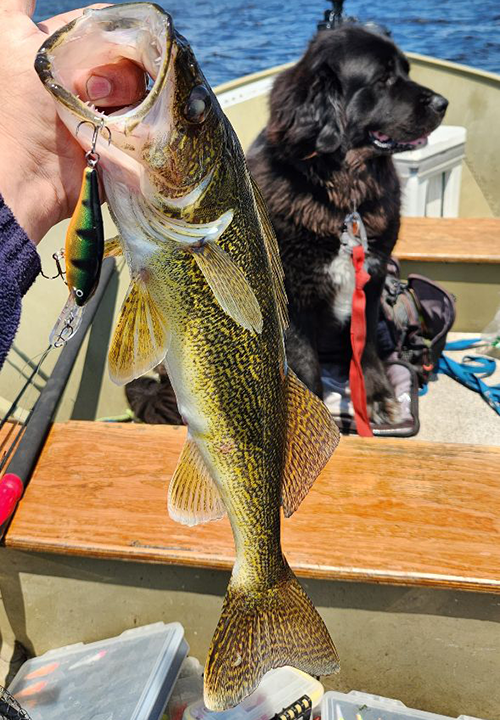 Daniel Hamilton wrote; "It was a pretty good weekend out of duluth. Pulling cranks along the drop off worked very well. We tried spinners on bouncers for a while, the catch was smaller and fewer. Not sure if the difference was the higher speed covered more ground and found more active fish or if it was just because it was different than what every one else was doing. Action was best when the wind kicked up and the fog rolled in off the lake.
Daniel Hamilton wrote; "It was a pretty good weekend out of duluth. Pulling cranks along the drop off worked very well. We tried spinners on bouncers for a while, the catch was smaller and fewer. Not sure if the difference was the higher speed covered more ground and found more active fish or if it was just because it was different than what every one else was doing. Action was best when the wind kicked up and the fog rolled in off the lake.
The dog is named Diesel, he is 3/4 Newfoundland and 1/4 Great Pyrenees. He is a rescue that was surrender from a neglect situation. He has been with me for 2 months after being fostered for 6 months. He is doing really well and loves to be in the boat." Daniel Hamilton
 Reader Comments June 5, 2023 "Reader Fishing Report"
Reader Comments June 5, 2023 "Reader Fishing Report"
Travis Verdegan wrote; "My son and I went out on Winnie with some family friends for the first time this year on Friday evening. By my standards we did pretty good with enough fish for a two-family fish feed and a package to for their freezer.
Most of our fish came on the break from 12 - 18 ft before and after sundown. We only fished jig and minnows and there seemed to be a preference for chartreuse. I thought about setting the boys up with some lindy rigs as they preferred to put their rods into the holders and eat snacks in between the action. I never made it that far as they caught a few fish just dragging a jig and dead minnow along.
Thanks for all you do to keep us all informed and hopefully I can find some more time to get out on the water in the not-too-distant future.” Travis Verdegan
 Jeff Sundin June 4, 2023 "Fun (in the bulrushes) With Dick and Paul MMXXIII"
Jeff Sundin June 4, 2023 "Fun (in the bulrushes) With Dick and Paul MMXXIII"
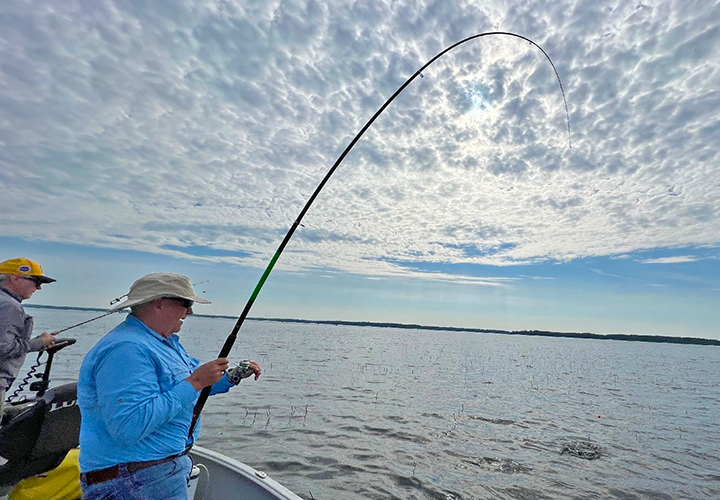 Dick Williams and Paul Kautza have been fishing in the Lake Winnie region for something like 50 years now. Before I ever arrived on the scene, they fished with some of the local legends like Steve Lamb, Eldee St. Peter and Tim Dorholt. Neither of them can remember ever in all all those years, starting any fishing day on any early June trip without a jacket, raincoat or at the least, a sweatshirt. That cycle is broken this year, they've started and finished the first 4 days of their trip without ever once adding a stitch of clothing beyond their shirt sleeves. And if the weather forecast for today holds, today is likely to be day #5 of the same.
Dick Williams and Paul Kautza have been fishing in the Lake Winnie region for something like 50 years now. Before I ever arrived on the scene, they fished with some of the local legends like Steve Lamb, Eldee St. Peter and Tim Dorholt. Neither of them can remember ever in all all those years, starting any fishing day on any early June trip without a jacket, raincoat or at the least, a sweatshirt. That cycle is broken this year, they've started and finished the first 4 days of their trip without ever once adding a stitch of clothing beyond their shirt sleeves. And if the weather forecast for today holds, today is likely to be day #5 of the same.
So, what is all this warm sunshine doing to the lakes? Well, for one thing, the surface water temperature was 79 degrees yesterday. Seriously, 79 degrees? Yes, that’s what we discovered yesterday in the northwest corner of the Third River Flowage, a couple of miles upstream from Lake Winnibigoshish. On the main lake, we found temperatures ranging anywhere from 71 degrees on up to 76 degrees.
Alage blooms are trying to take hold, and the water is starting to get a little color. But the "zeebs" and faucet snails are still winning the battle; most of the water on the big lake is still very clear. Last evening, we ran into a friend, Dale Anderson at the Gosh Dam Place and he said that on his fishing charter yesterday, they could see their lures on the bottom is 13 feet of water. I too, noticed the water clarity, we were able to watch the bottom structure whizzing by as we motored from spot-to-spot.
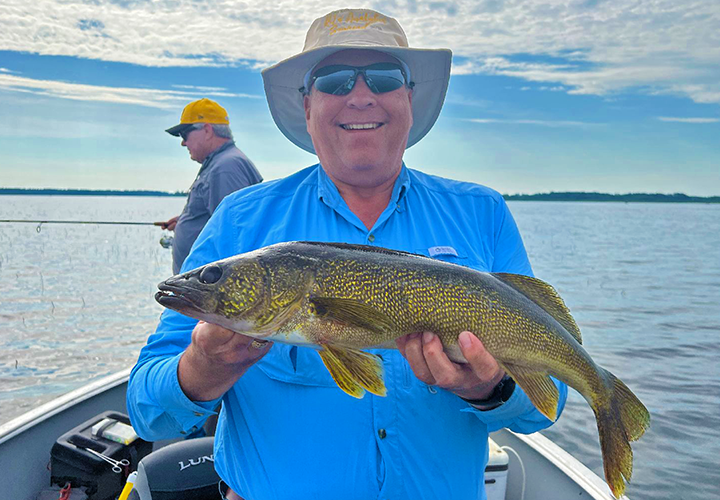 As warm as it is, insect hatches appear not to be arriving any earlier than usual. Except for the tiny, almost microscopic white critters that gather on our clothes, none of the larger fish flys, or mayflys have emerged. Folks who are traveling around, scanning mid-lake structure for fish are seeing little, if any, insect larvae on their graphs. So, this means that except for a select few locations, most of them very close to the shoreline, walleye are not gathering on mid-lake structures either.
As warm as it is, insect hatches appear not to be arriving any earlier than usual. Except for the tiny, almost microscopic white critters that gather on our clothes, none of the larger fish flys, or mayflys have emerged. Folks who are traveling around, scanning mid-lake structure for fish are seeing little, if any, insect larvae on their graphs. So, this means that except for a select few locations, most of them very close to the shoreline, walleye are not gathering on mid-lake structures either.
Another impact of the warm, calm water appears to have accelerated the timing of spawning pattern for crappies. When we went looking for them in their usual haunts on Saturday, all we found in shallow back bay areas were rock bass, largemouth bass and believe it or not, the occasional walleye. In fact, rigged up with brand new “cane poles”, Paul’s first fish of the day was a walleye. As you can see, it was a very nice one at that, and the long extending rods, foam bobbers and crappie minnows, intended for fishing in heavy cover like bulrush or lily pads can do more than produce panfish.
When we found the shallow water vacated of crappies, we pulled out into deeper water and began trolling though sparse patches of cabbage. We caught walleyes, pike, a couple of small perch and some more rock bass. But having caught no crappies, and not “needing” to catch any more walleyes, we thought that fishing for perch could be a good 2nd choice. To do that, we were prepared to load up the boat and trailer to another lake.
On the way out, I saw a friend and pulled alongside to see how he’d been doing. He turned me on to a location where the perch had been present earlier in the morning. I had a quick conflab with Dick and Paul, and we agreed the idea of staying on Winnie sounded good, so we took my pals advice and motored over to the spot, hoping to get in on the action. But apparently our timing was off, and by the time we arrived, the perch, at least “keeper size” perch had wrapped up their morning session. Under the hot afternoon sun, they were holed up somewhere, waiting for the next window of feeding opportunity.
Food and feeding was definitely driving fish location this week. Tiny 3/4 to 1 inch long perch are showing up daily in the bottom of my fish cooler. Those tiny perch, along with other minnows remain in the shallows, wherever there is low-lying crassy cover. Walleyes, along with other predators are there feeding almost exclusively on them. The next big change in location will be driven by insect hatches and the subseqent, temporary shift away from shallow water cover. I'll be amazed if that doesn't start occuring this week, but we won't know for sure until it happens, so stay tuned.
With all the walleyes that the boys can legally possess already wrapped and frozen for the ride home, we’ll be looking for something else to fish for today, the question is what that will be. They’d like to take home some perch, but Monday’s weather report looks better for doing that. Crappies are still an option, so I’m thinking today about taking a swing at one of the areas deeper, clear water lakes where we can sport fish for bass and while we’re at it, maybe stumble into some crappies that haven’t completed spawning yet.
As usual, most of whatever we learn today, you’ll know about tomorrow.
 OH, and before I go, let me share the email note I got from Bob Noonan on Friday. Bob's claim to fame, or "career highlight" as he calls it, was when he served as the food service director for the World Champion Chicago Bears, from 1984 through 1995. These days, Bob enjoys fishing and apparently, reading my anecdotal stories from the lake.
OH, and before I go, let me share the email note I got from Bob Noonan on Friday. Bob's claim to fame, or "career highlight" as he calls it, was when he served as the food service director for the World Champion Chicago Bears, from 1984 through 1995. These days, Bob enjoys fishing and apparently, reading my anecdotal stories from the lake.
"Snackle Boxes", the name Bob uses for his adaptation of Plano's portable tackle trays. Noonan, "As a retired in-fisher chef with time on my hands. I thought you'd enjoy a recent project my wife and I came up with for picnics and in the boat. We use the Plano StowAway 2363001 (22x7x2 1/2 inches) to store our meats, cheeses and vegetables, along with other Charcuterie items. The amazing thing is they fit into an Igloo cooler, still leaving room in the bottom for ice and condiments. We keep the gourmet crackers separate and added cocktail forks, ice tongs & mini-butter knives with it. I'm sure our wives will like to add a chilled bottle of Riesling to go along with the snacks. It sure beats a ham sandwich." Regards, Bob Noonan
That you Bob, your "Snackle Boxes" look like a handy idea to me. You can rest assured that I definitely will share this idea with my lovely and gracious wife, she is always looking for better ways to pack food for the boat. ![]() — Jeff Sundin 218-245-9858 or EMAIL
— Jeff Sundin 218-245-9858 or EMAIL
 Jeff Sundin June 2, 2023 "Fun (in the sun) With Dick and Paul MMXXIII"
Jeff Sundin June 2, 2023 "Fun (in the sun) With Dick and Paul MMXXIII"
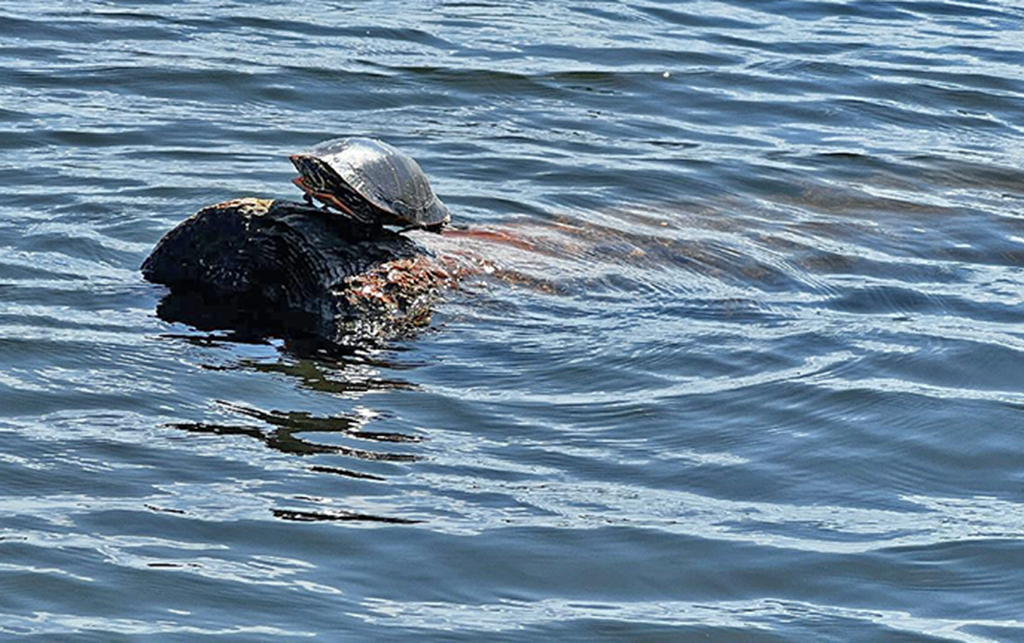 Fun with Dick and Paul 2023 spring session started on Wednesday and with sunshine and hot air temperatures, its been a dparture from the norm.
Fun with Dick and Paul 2023 spring session started on Wednesday and with sunshine and hot air temperatures, its been a dparture from the norm.
As usual, walleyes were on the opening day agenda. We started on Winnie that day, and we fished in the aftermath of thunderstorms that moved through overnight Tuesday. We found fish, caught enough to provide the evening meal, and even had a few extras for the freezer. But the action had slipped when compared to what folks enjoyed over the Memorial Day holiday.
One thing that made life easier, for me, was that some of Winnie’s walleyes have begun moving onto offshore structures. Isolated bars and sunken islands held some fish, and they were easily spotted on the Humminbird. They were holding in water depths of 22 to 26 feet along the edges of the bars.
Jigs and minnows provided enough action so that we could count on that presentation. So, we did not experiment with alternatives, but I would have loved to try Lindy Rigging with large minnows. There were some nice-looking marks on my graph, larger fish in my view and Dick help bolster the theory by catching a couple of 24–25-inch walleyes. There were pike on the bar too and we caught a few “slot-fish” jigging; I’ll bet that larger minnows would have produced a couple of larger pike too.
During the afternoon, we searched the shallows for crappies and did find some, but they were not present in large numbers. The size of those fish, 12 to 13 inches, helped make up for the low numbers and makes me want to try again once the weather stabilizes.
 The primary reason for wanting to schedule a “do over” is to get even with those fish for ruining my day on Thursday. You’re probably wondering, how could catching nice size crappie one day, cause me to have a brain meltdown the next day? Well, those fish raised the bar on what the boys considered “keeper size” crappies. So, even when we caught a lot more crappies on Thursday, the size structure, 10 to 11 inches didn’t do very much to excite them. It didn’t help that the boys had seen photos of the large size fish that Penny Becker (image right) caught on Tuesday, and the ones that the Hippie Chick (Full Report May 28) caught a few days before that. So, while most folks would have been thrilled to catch the ones we caught on Thursday, the boys only deemed 4 of those fish to meet the current criteria, somewhere in the 12-inch range, apparently.
The primary reason for wanting to schedule a “do over” is to get even with those fish for ruining my day on Thursday. You’re probably wondering, how could catching nice size crappie one day, cause me to have a brain meltdown the next day? Well, those fish raised the bar on what the boys considered “keeper size” crappies. So, even when we caught a lot more crappies on Thursday, the size structure, 10 to 11 inches didn’t do very much to excite them. It didn’t help that the boys had seen photos of the large size fish that Penny Becker (image right) caught on Tuesday, and the ones that the Hippie Chick (Full Report May 28) caught a few days before that. So, while most folks would have been thrilled to catch the ones we caught on Thursday, the boys only deemed 4 of those fish to meet the current criteria, somewhere in the 12-inch range, apparently.
Depending on which lake(s) you fish this weekend, crappie patterns will be in different stages of development. The crappies on the lake we fished yesterday were in the late stages of spawning, most females were out of the shallows already, only the male "nest guarders" remained. The ones we fished on Winnie this Wednesday were in the earliest stages of theirs, only bright and silvery females were in the shallows, no beds had been completed and males, dark black fish were not present. I think a good strategy for this weekend would be to try your favorite clear and cool water lakes for panfish.
Worth noting about Thursday’s fishing day was the water temperature. The readings I observed ranged consistently between 73 and 76 degrees, amazing readings for June 1st! It didn’t matter much whether we were in deep, shallow, windy, or calm water; it was just plain warm everywhere.
The warm water tempted me into taking a swing at fishing the deeper weed edges using spinners. We rigged up Little Joes and trolled the weed tops in water depths of 7 to 9 feet. The action was consistent, but the fish we caught represented a hodge-podge of odds and ends. There were lots of rock bass, lots of small pike, some crappies, a few perch and one nice walleye. The only fish we didn’t catch was a sunfish, almost all of them are apparently located along the shore, on or near their spawning beds.
Most years, we try to make a trip to Upper Red Lake and the weather forecast doesn’t look bad for doing that today. So, unless something changes my mid in the next couple of hours, that’s likely what we’ll do. ![]() — Jeff Sundin 218-245-9858 or EMAIL
— Jeff Sundin 218-245-9858 or EMAIL
 Ely Area, Arrowhead Outdoors Fishing Report June 1, 2023
Ely Area, Arrowhead Outdoors Fishing Report June 1, 2023
"Walleye - Skinny water has been has been the name of the game this last weekend. When we say skinny, we are talking 2-3 feet of water. Anglers catching walleyes in this super skinny water were throwing minnow baits or jig and a minnow to these shallow water walleyes, during the late evening hours and after dark (if you can handle the bugs). During the day it was a very different story for walleye anglers. 20-25 feet of water is where anglers were finding walleyes. Again jig and a minnow was the most popular technique to catch walleyes out here. With water temps getting into the 60’s leeches and a slip bobber are quickly coming into play on many area lakes.
Smallmouth Bass - The smallmouth invasion of the shallows is in full swing on all area lakes. Shallow boulder flats, around islands and along shorelines, are now covered with hungry smallies. Suspending minnow baits, soft plastics and even some topwater reports were heard this last weekend.
Pike - Pike anglers are still finding large pike shallow this last weekend. Pike continue to cruise shorelines and river mouths looking for a easy meal. Spoons, spinnerbaits and large minnows fished under a bobber has remained very effective on large pike.
Panfish - With water temps climbing into the 60’s, panfish anglers have been finding crappies and now sunnies in pencil reeds, staging to spawn. Hair jigs and crappie minnows were very effective on these shallow water panfish.
Stream Trout - Stream trout anglers continue to report catching good numbers of stream trout from area lakes. Small spoons, spinners and night crawlers fished under a bobber or floated off the bottom. Anglers should keep in mind that as water temps climb, trout will go deeper. Fish accordingly." — Arrowhead Outdoors, 218-365-5358